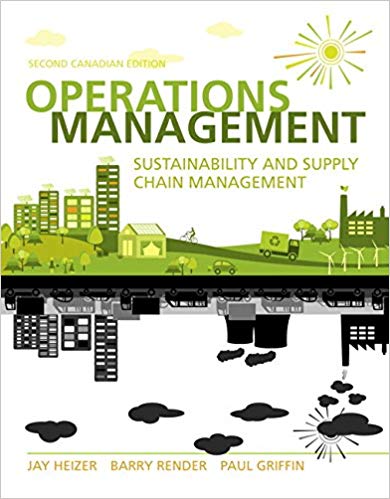Answered step by step
Verified Expert Solution
Question
1 Approved Answer
After reading the attached Article answer the below question with assignment (5 paragraphs) Which sections of the attached report could be the most useful for
After reading the attached Article answer the below question with assignment (5 paragraphs)
- Which sections of the attached report could be the most useful for understanding the company's strategic direction and cash allocations for innovation?
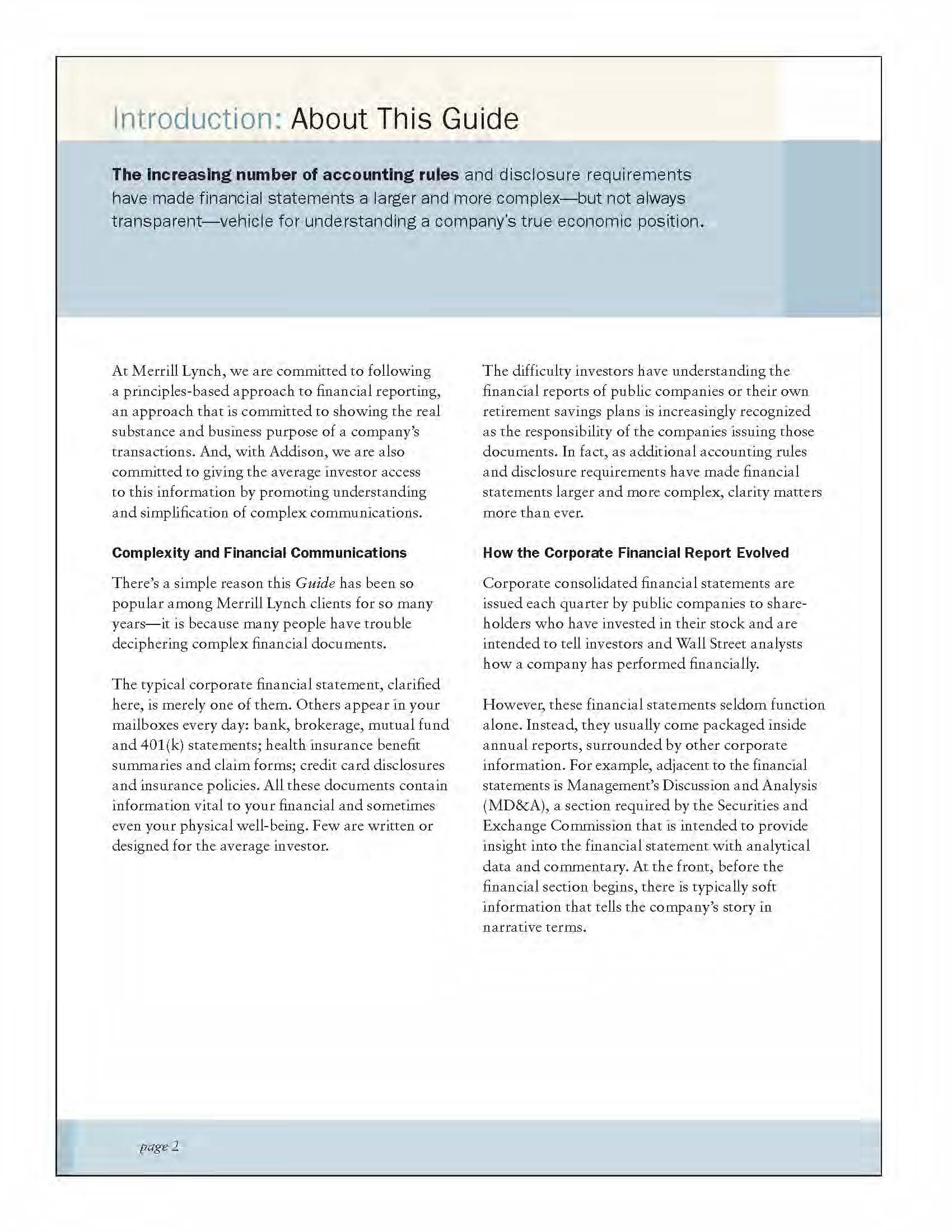
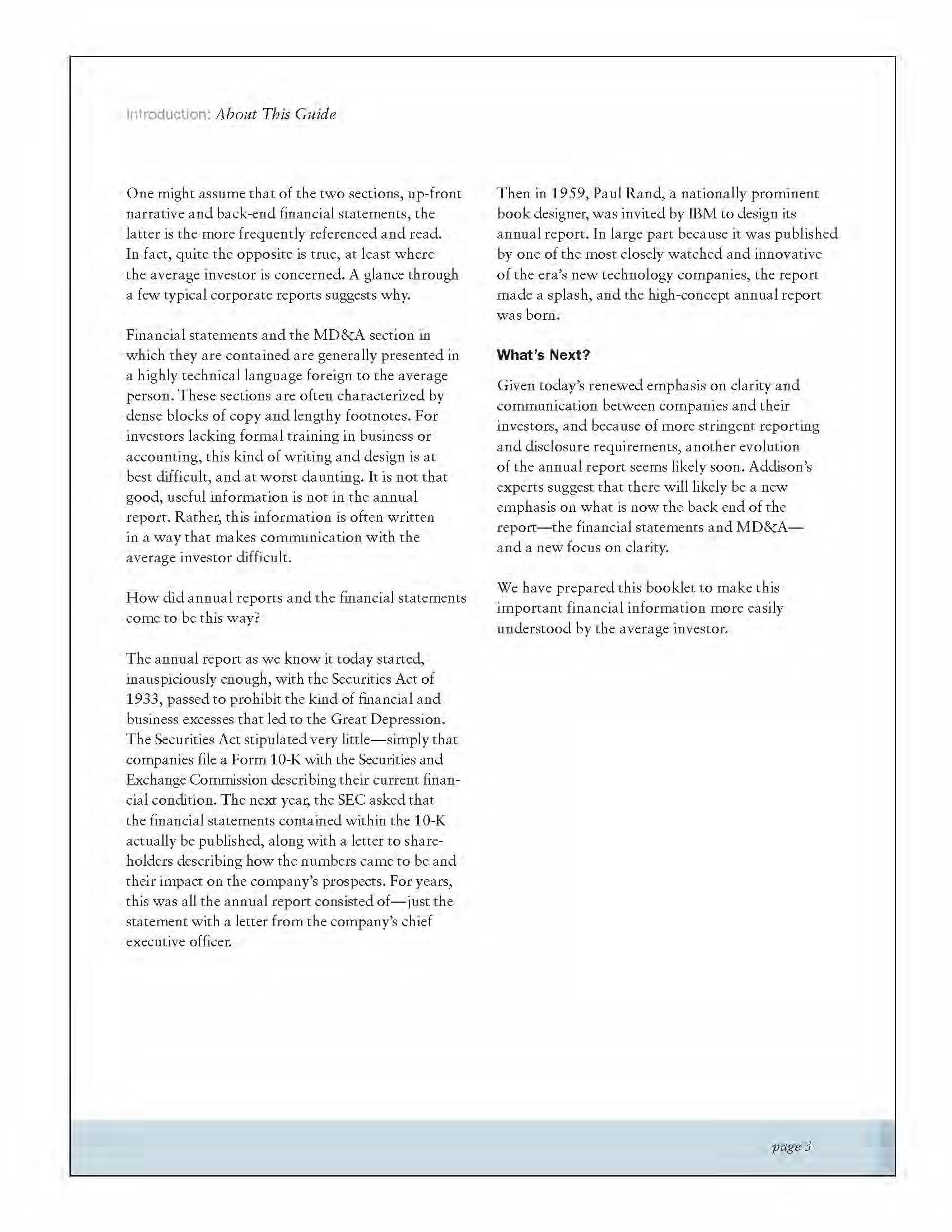
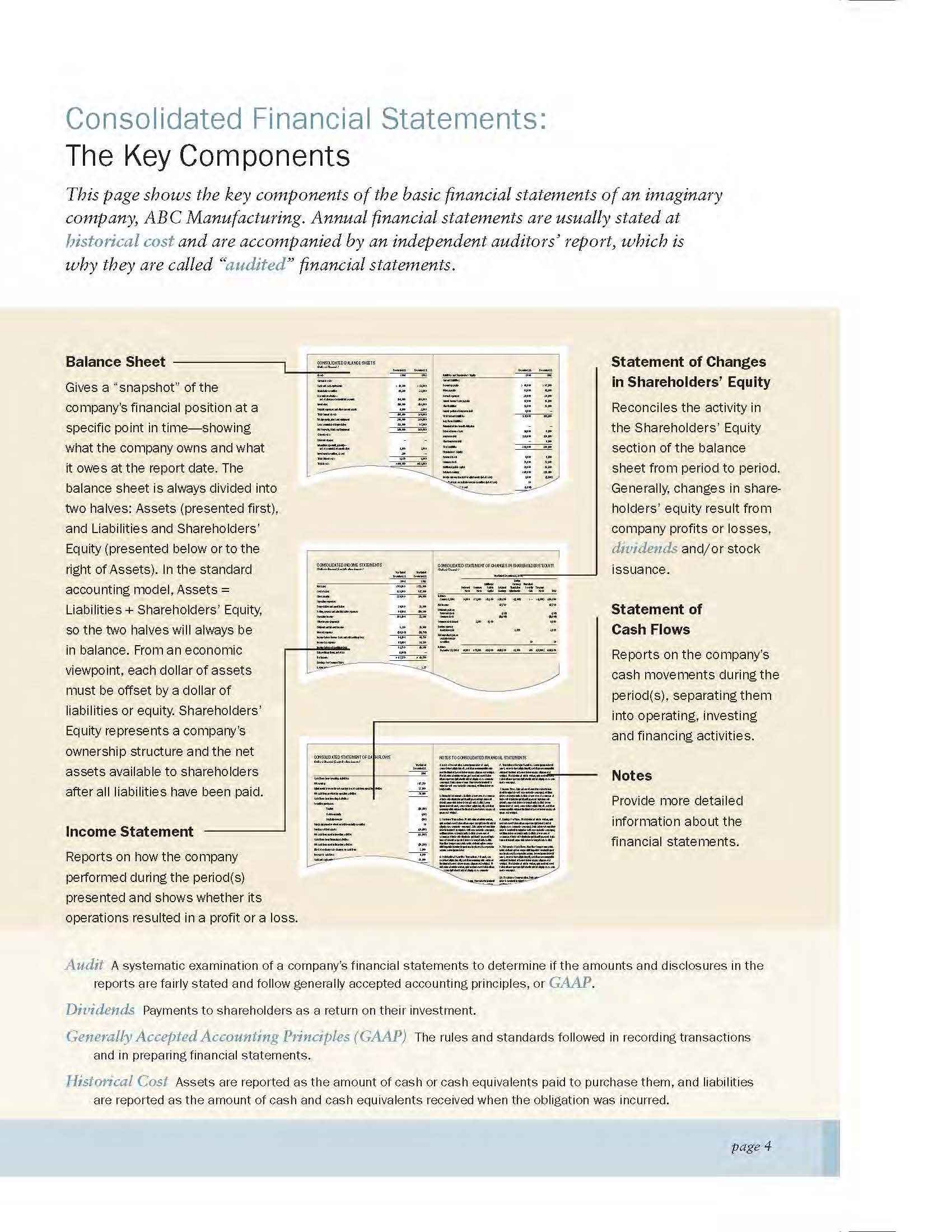
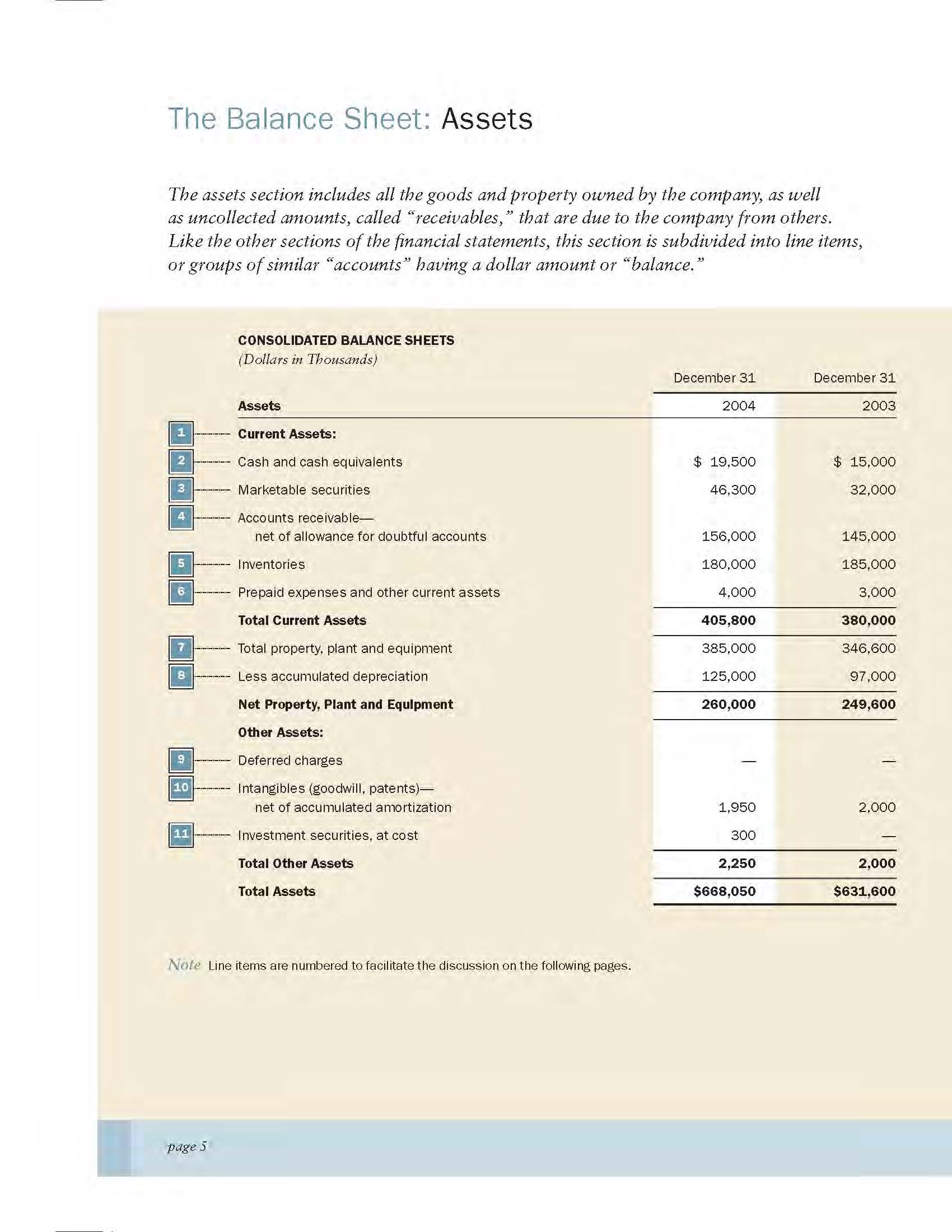

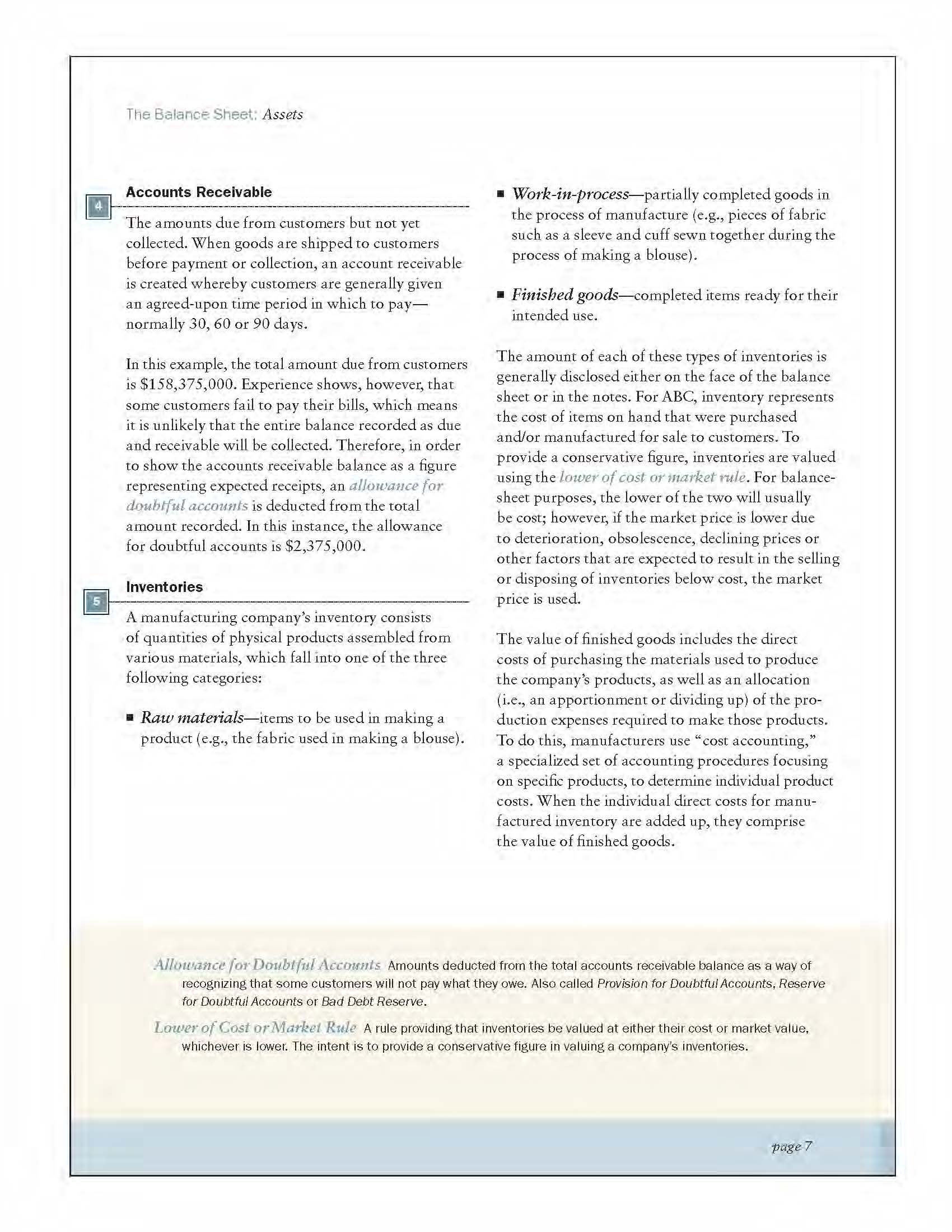
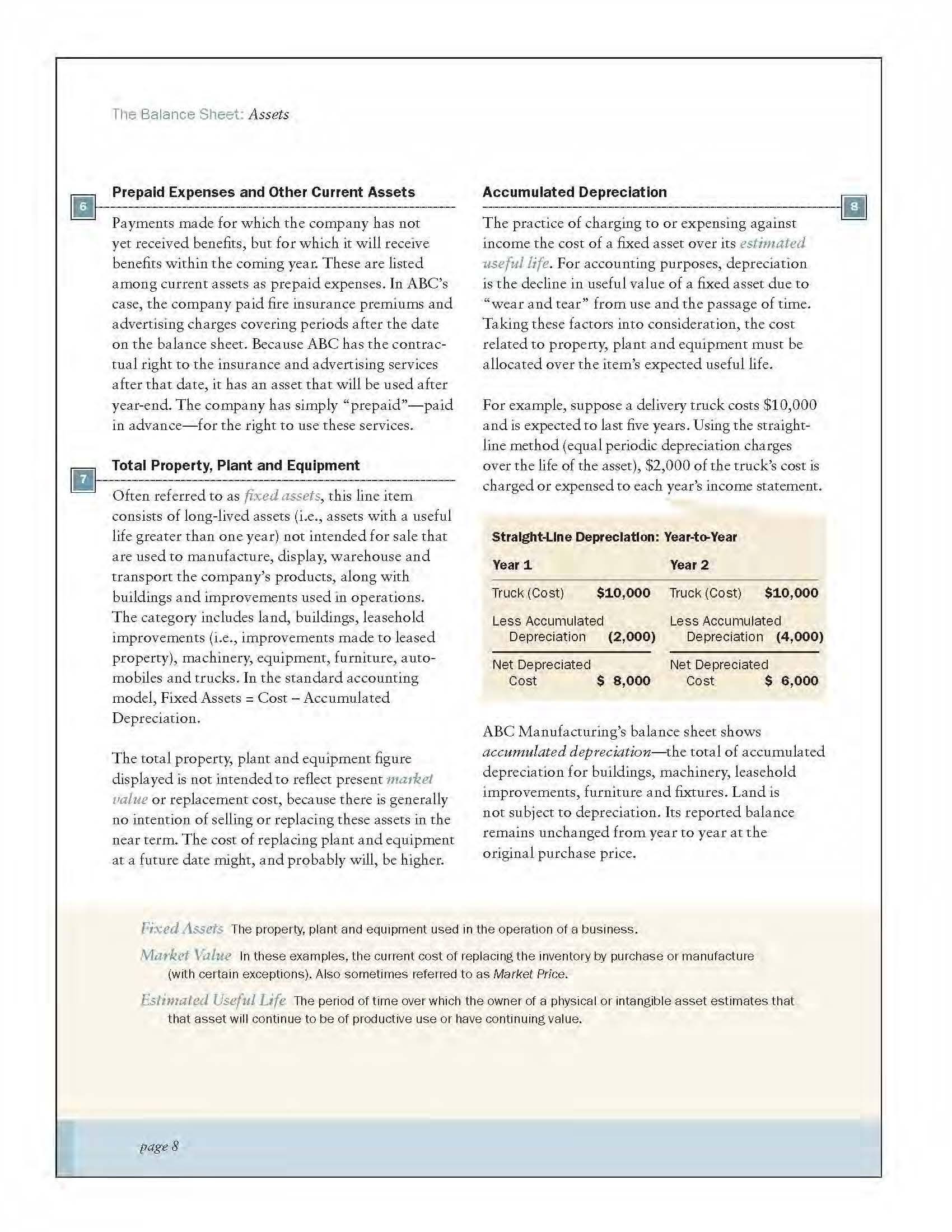
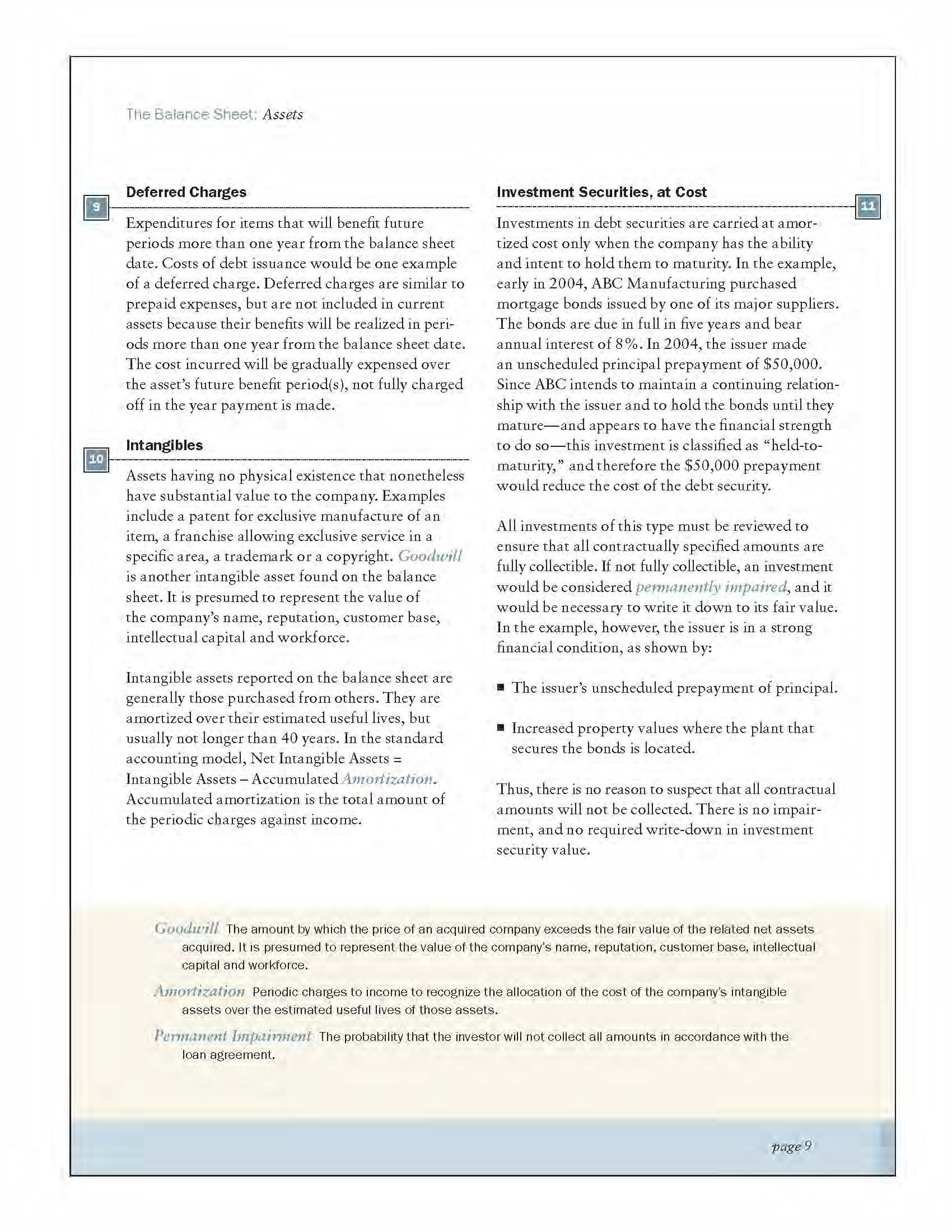
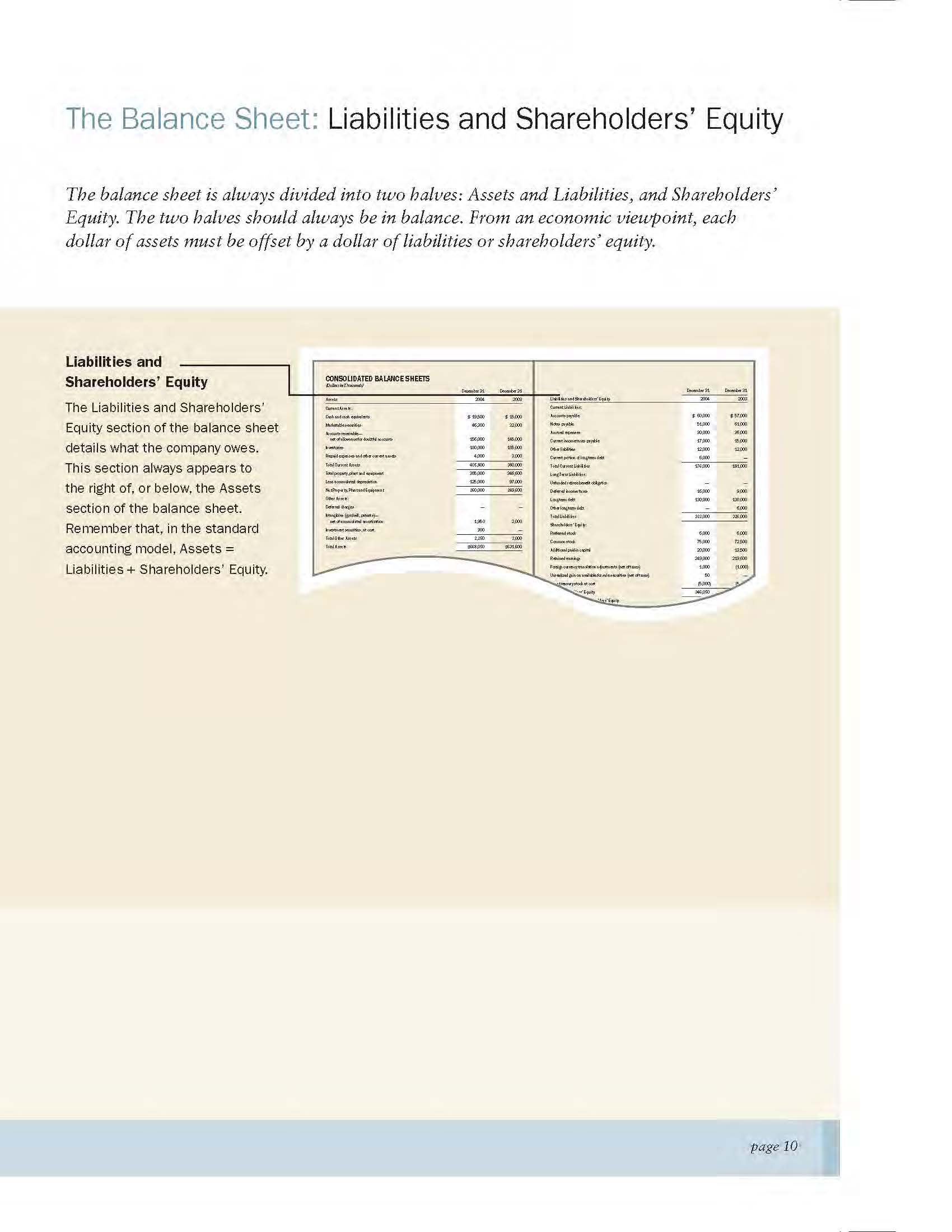
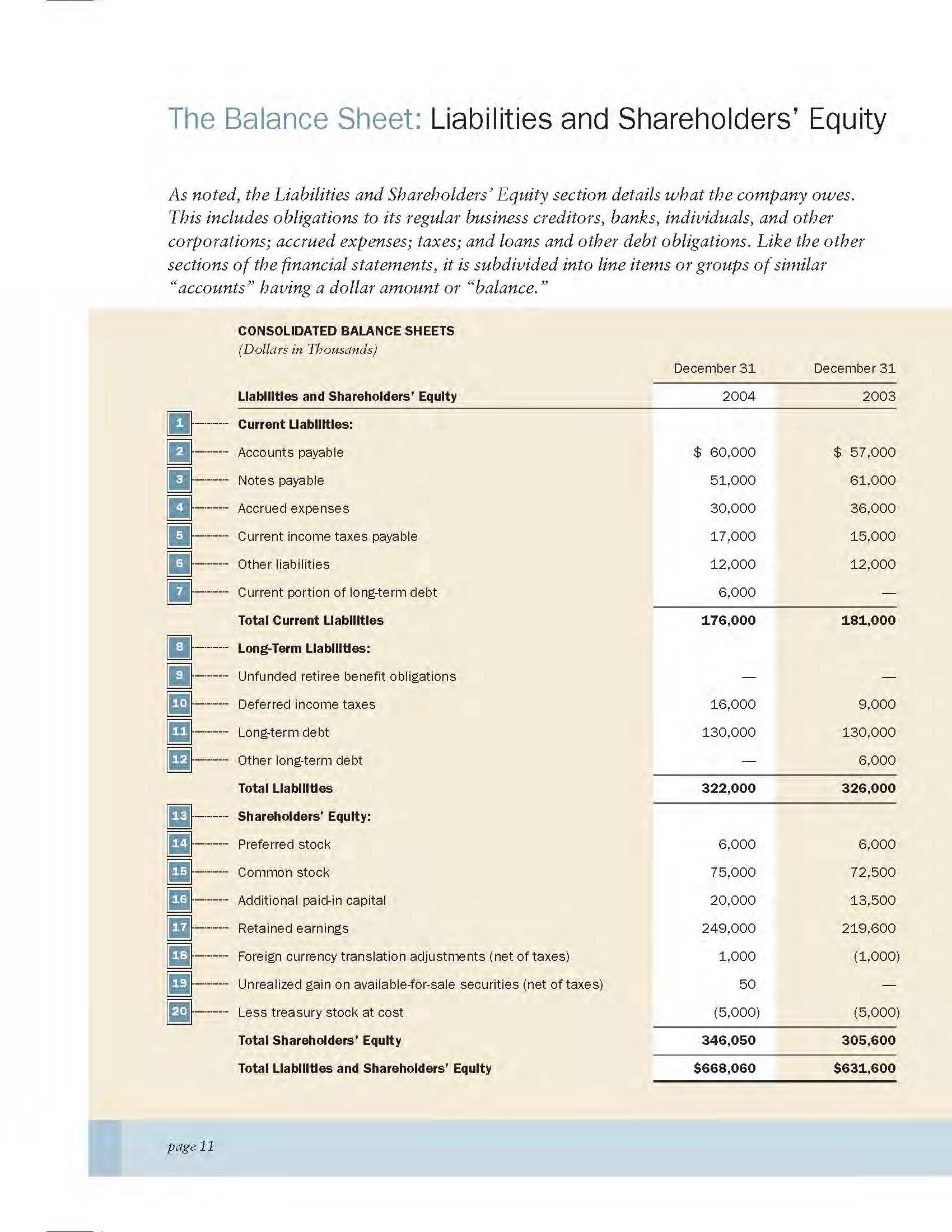
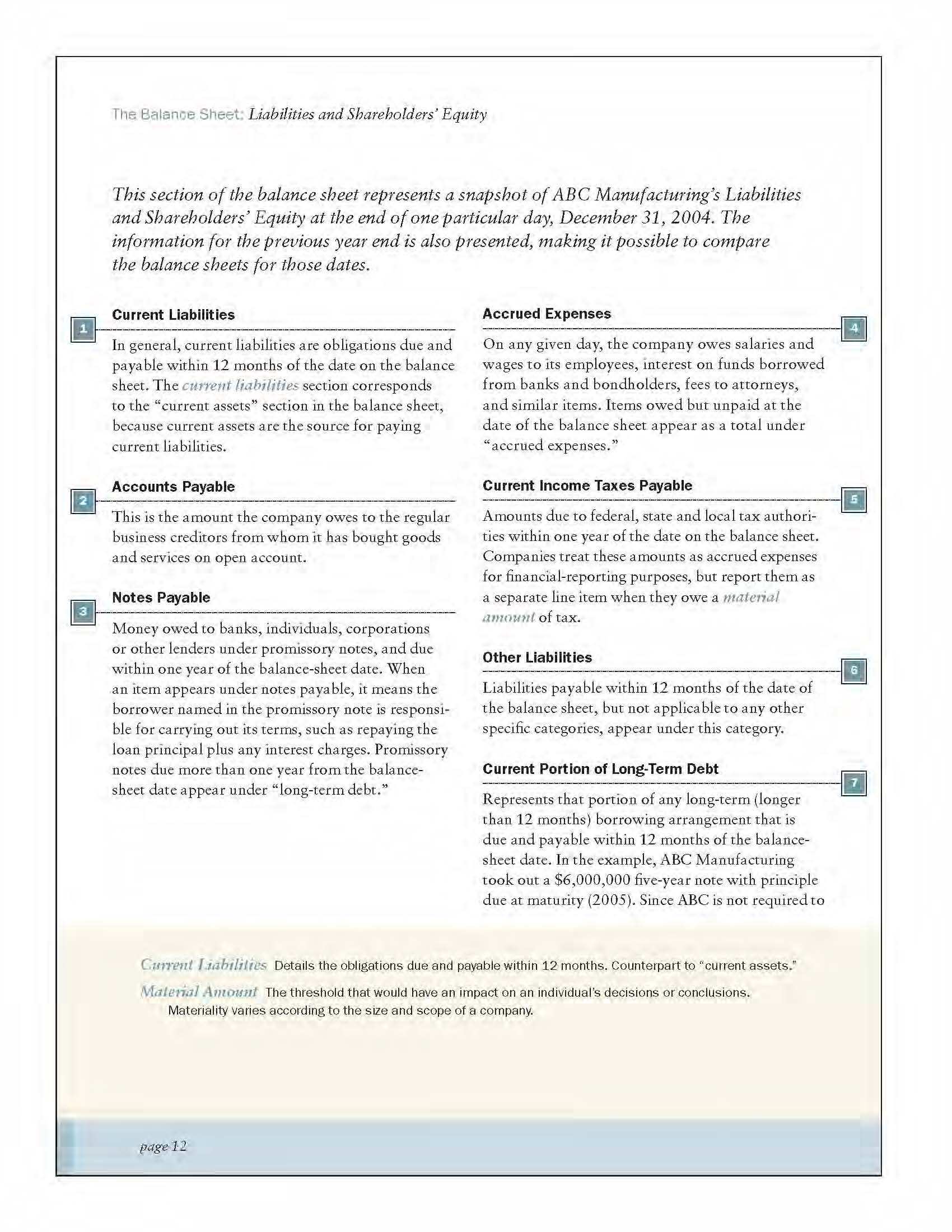
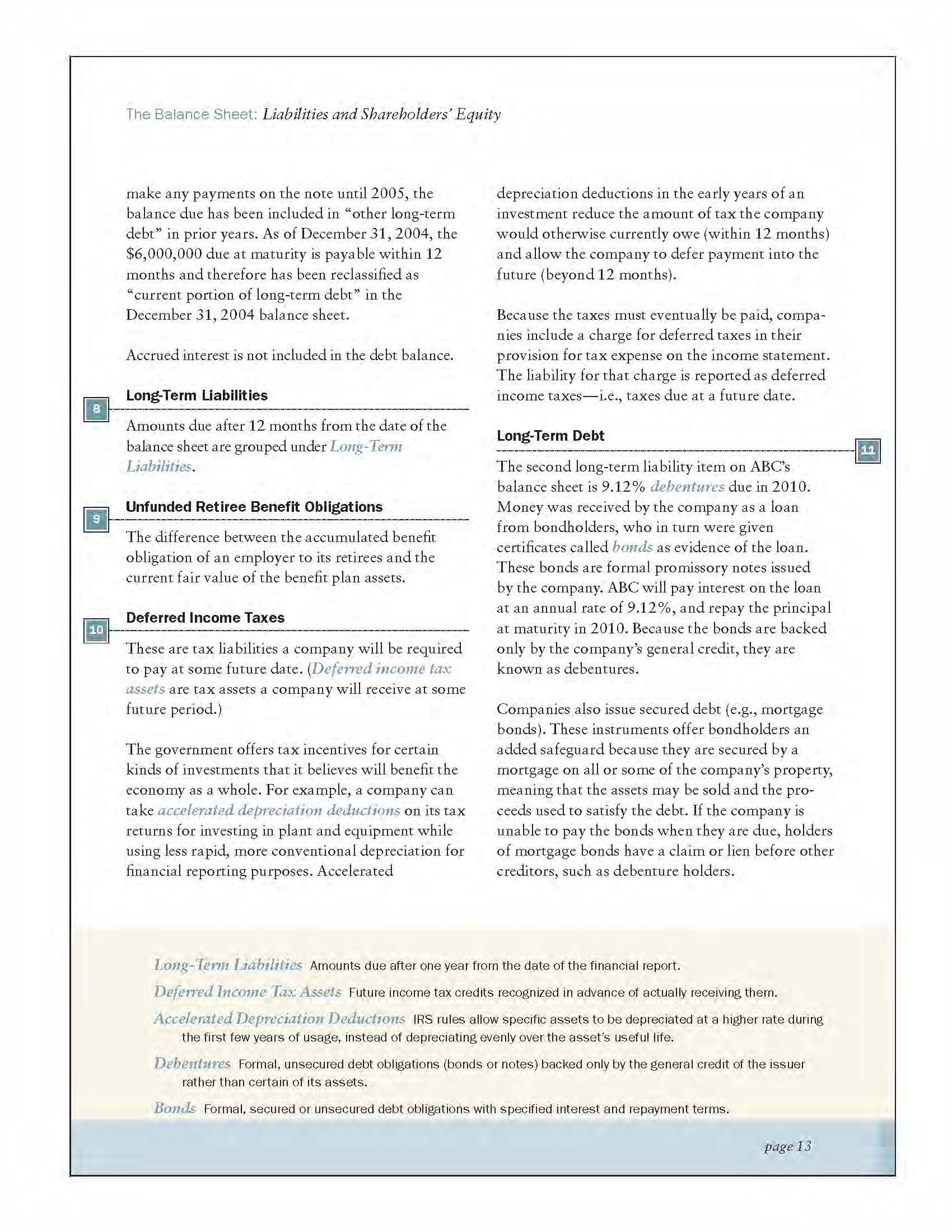
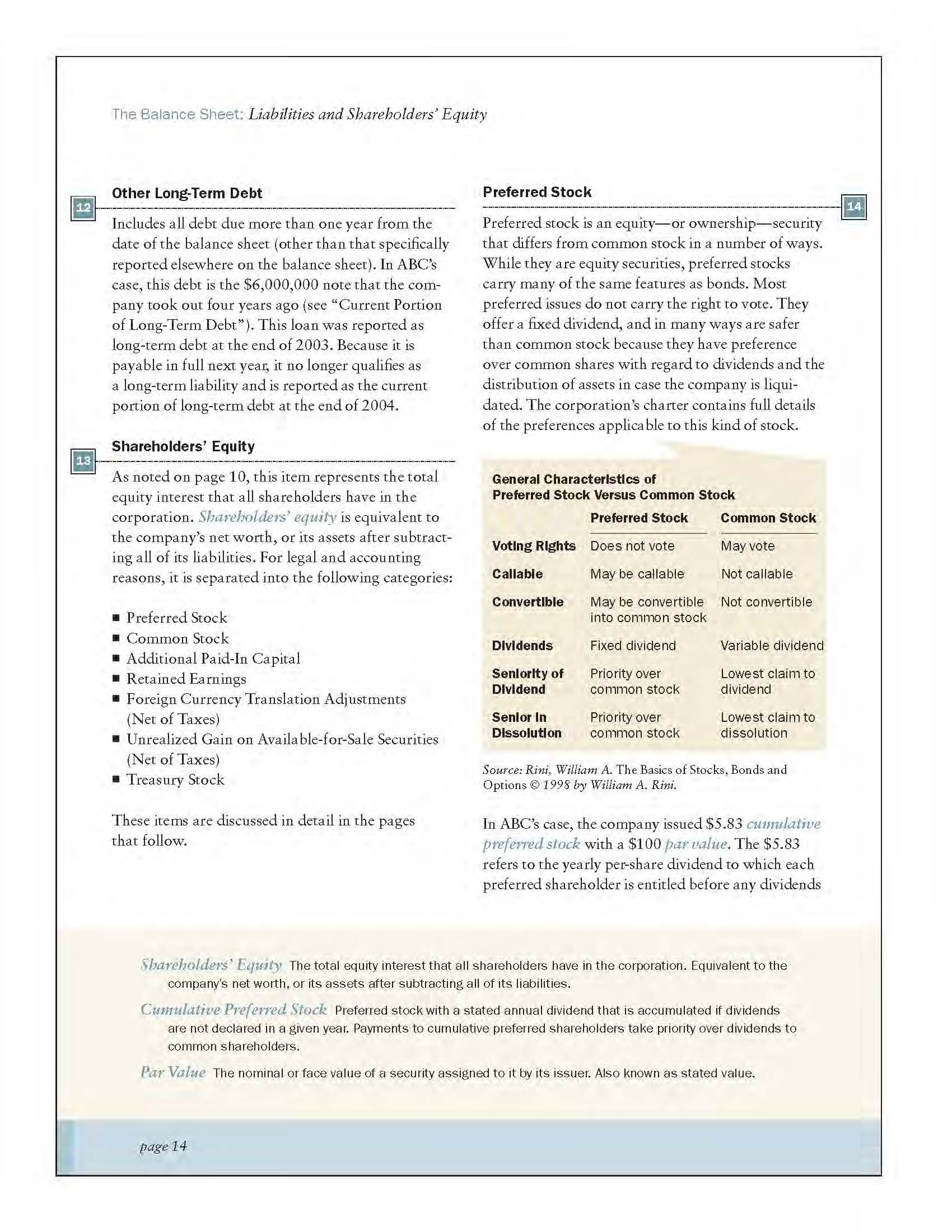
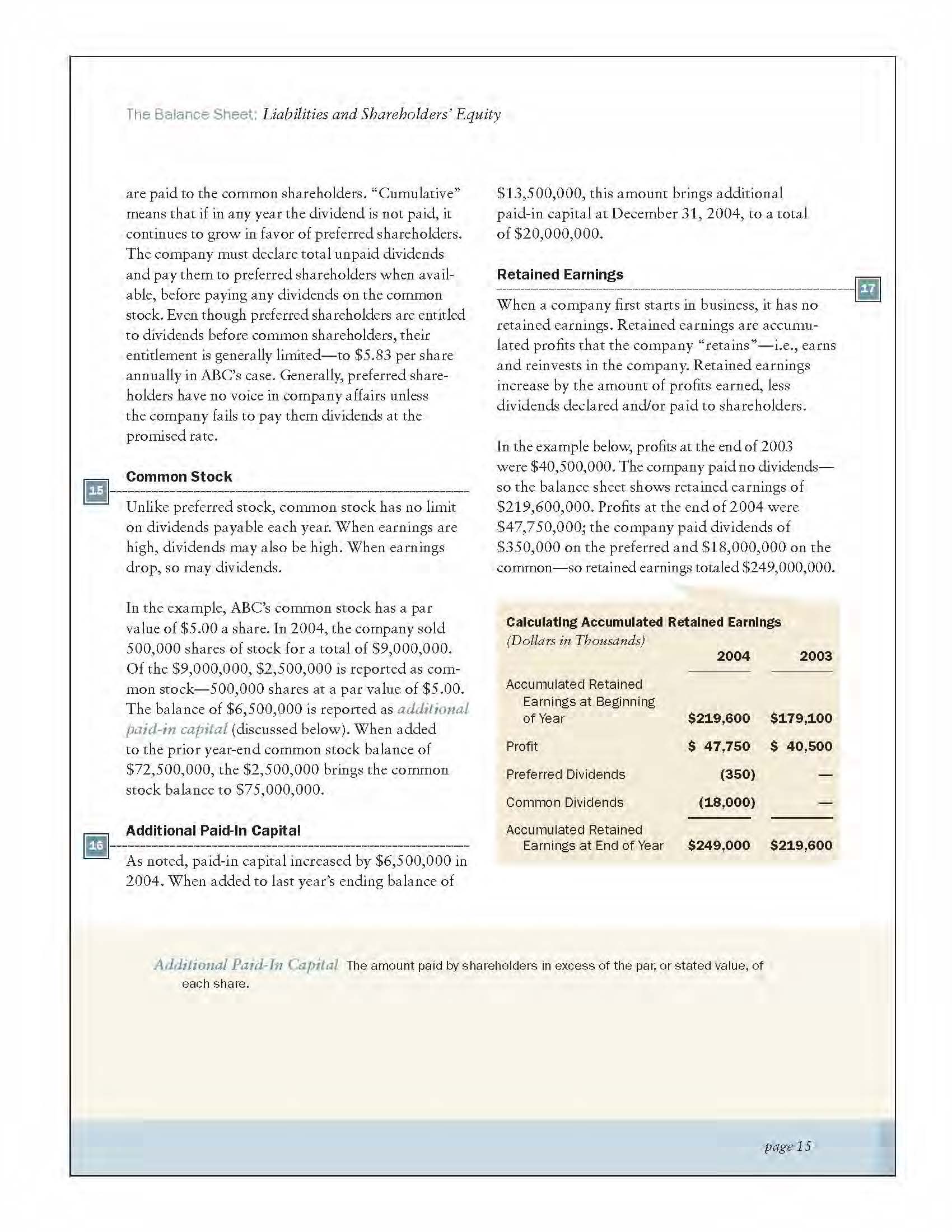

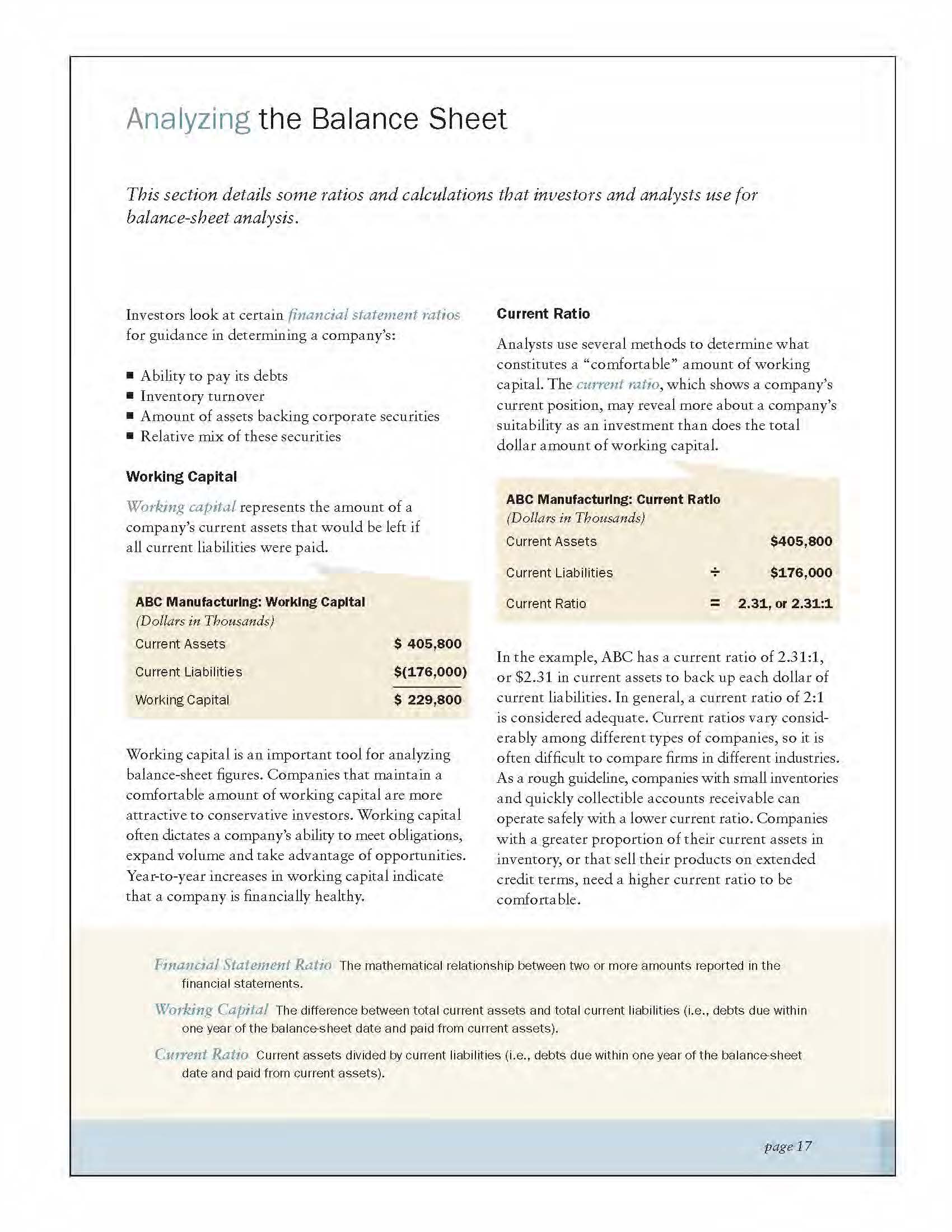
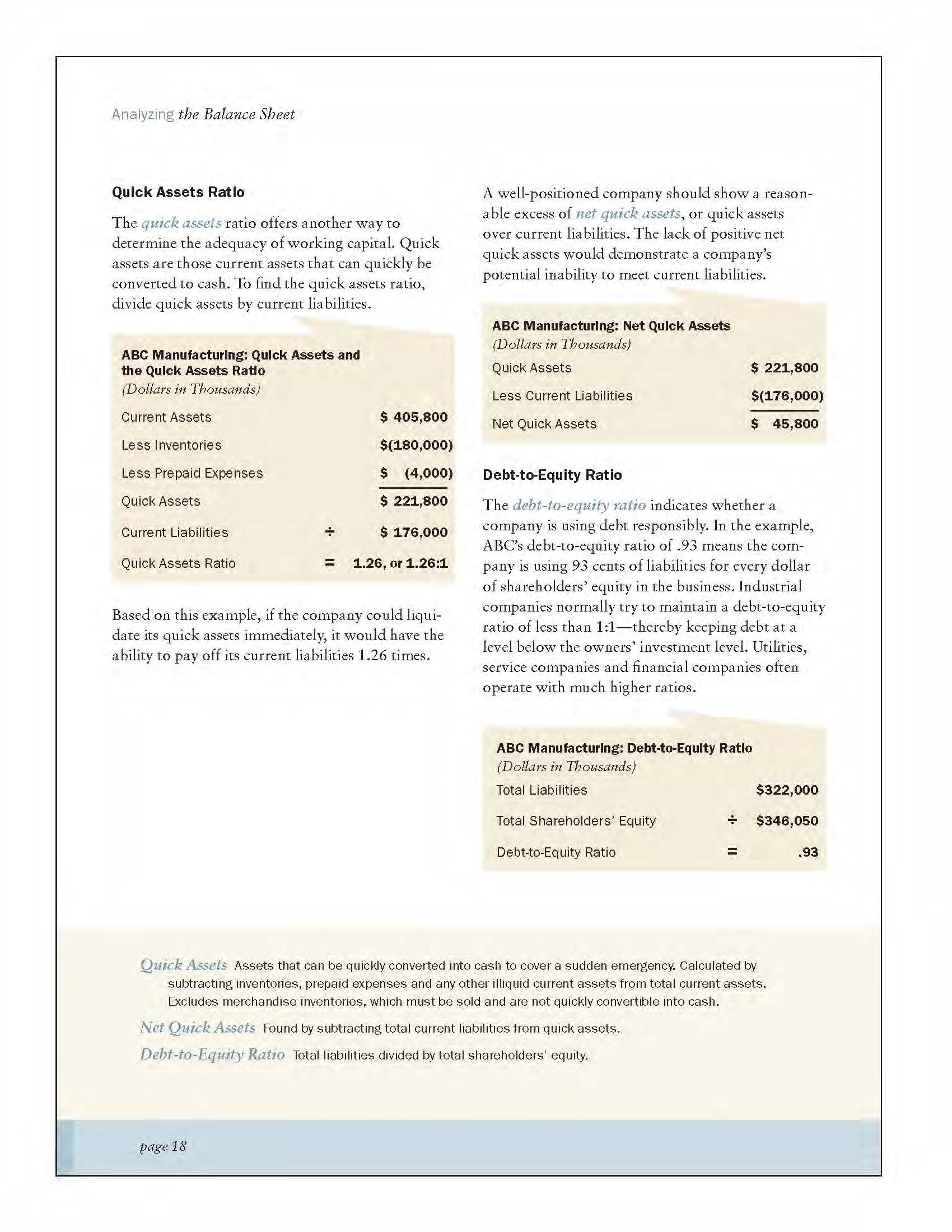
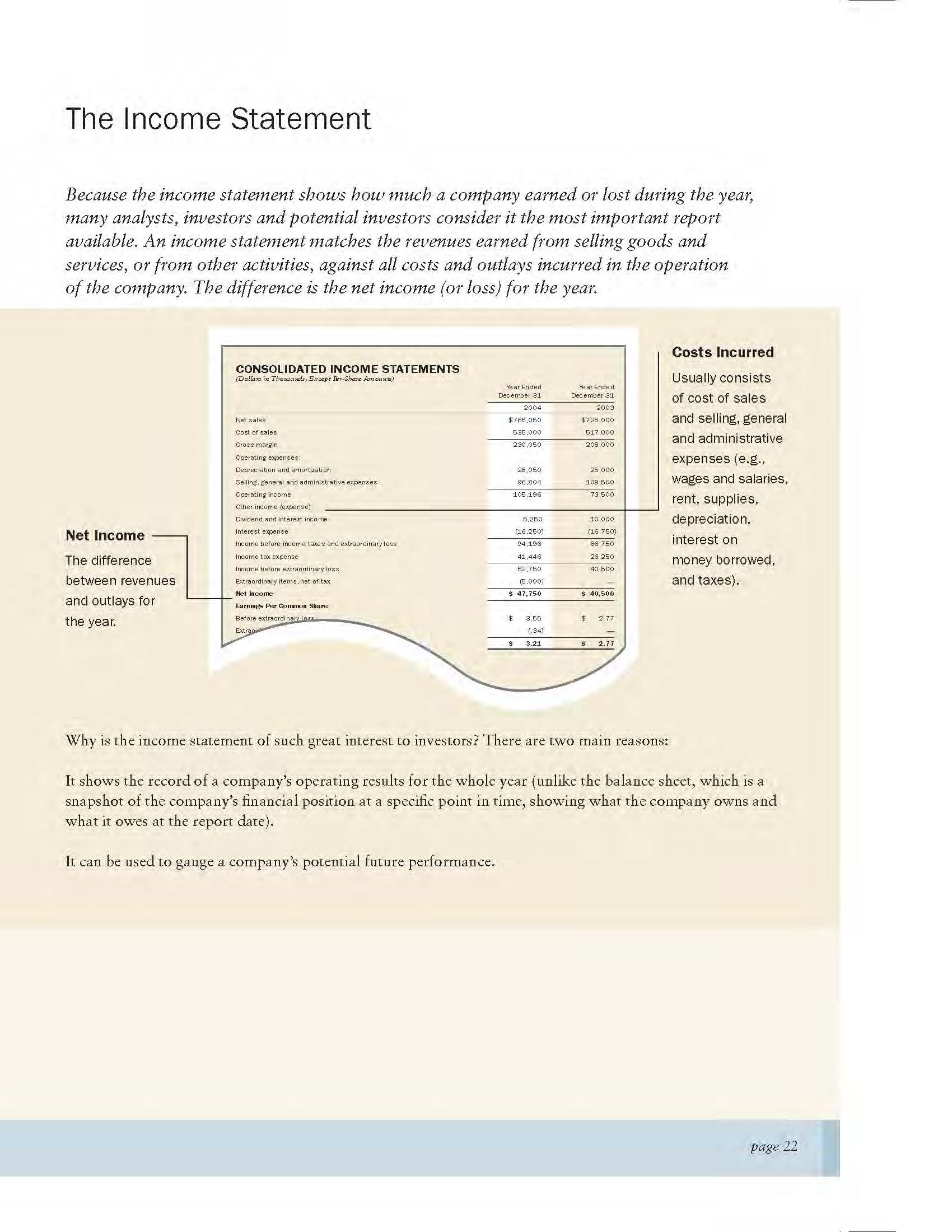
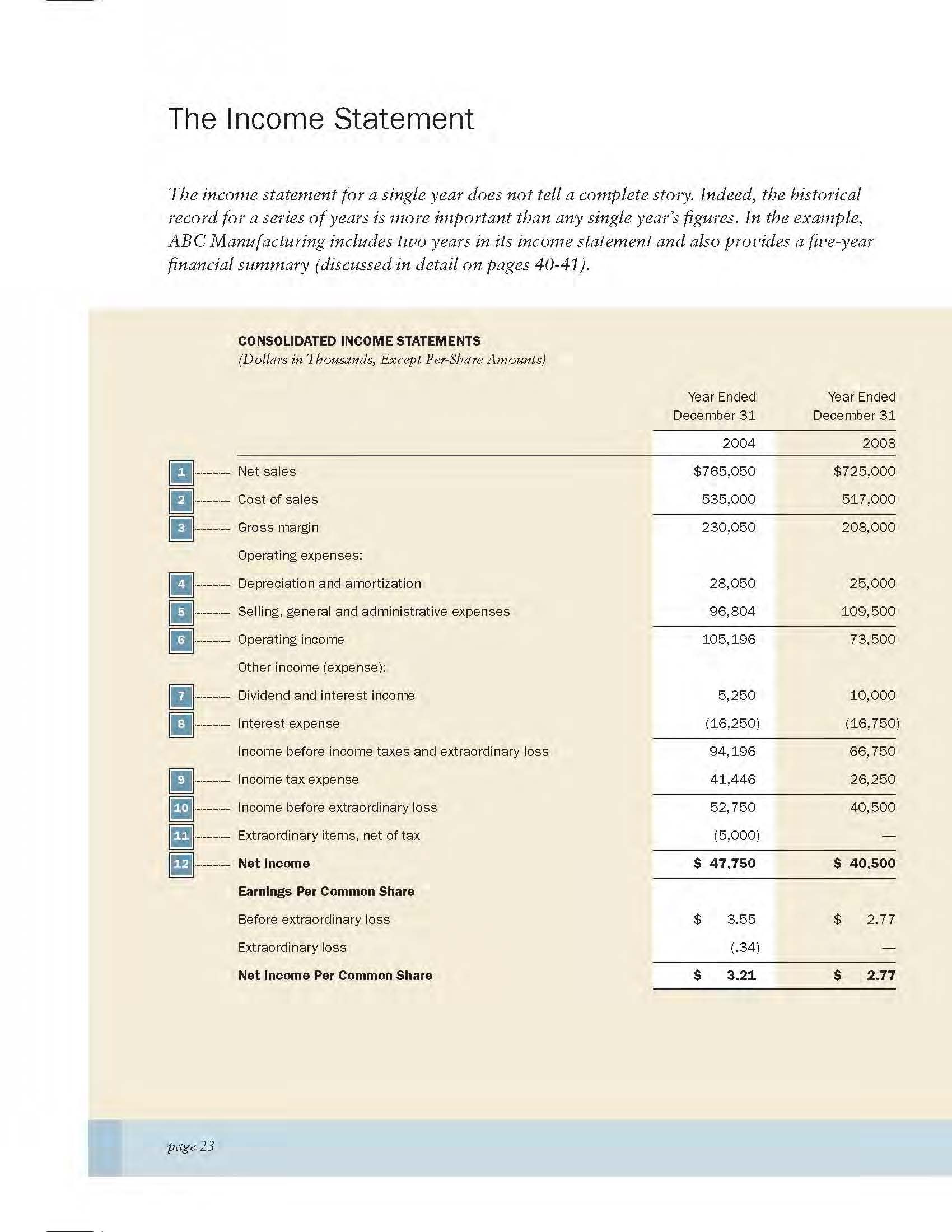
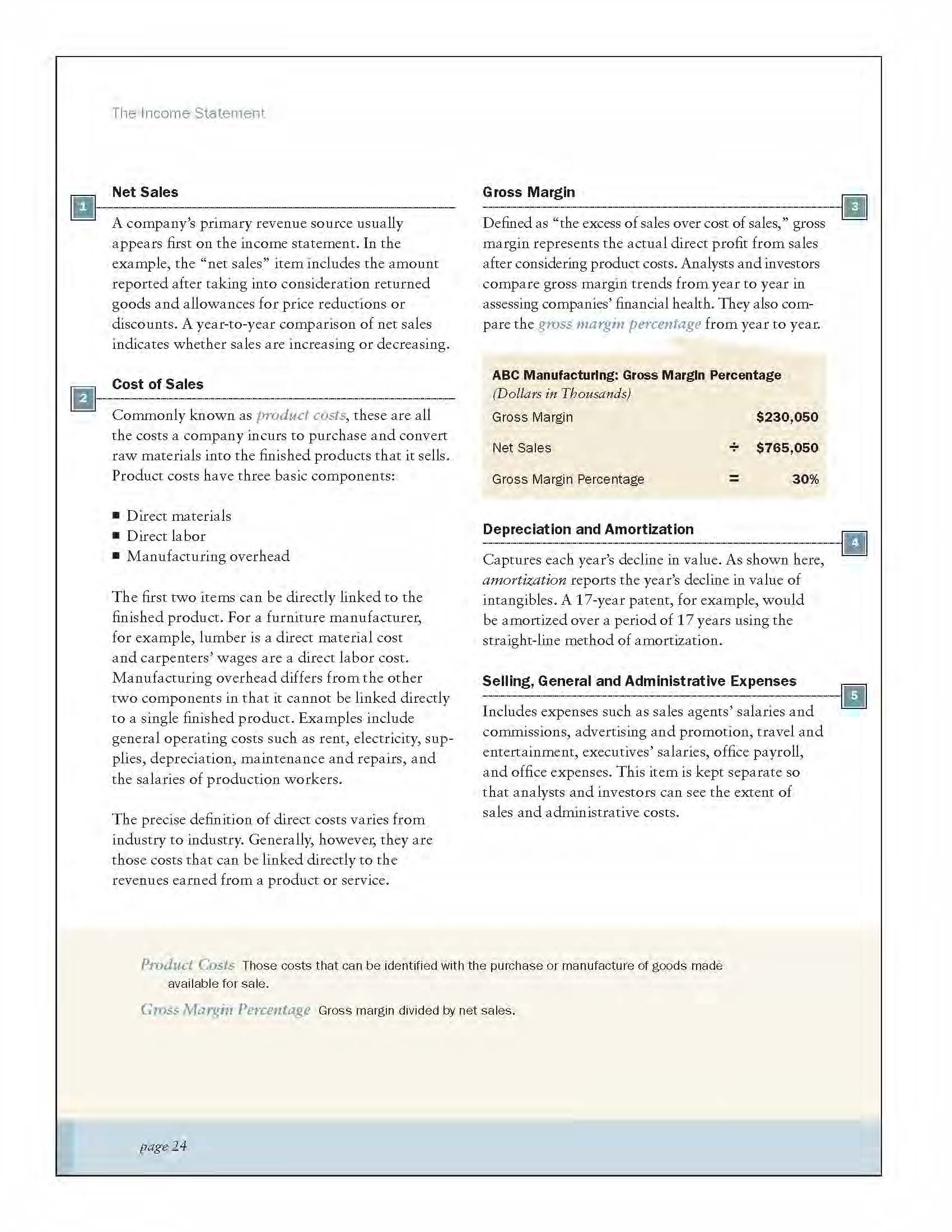
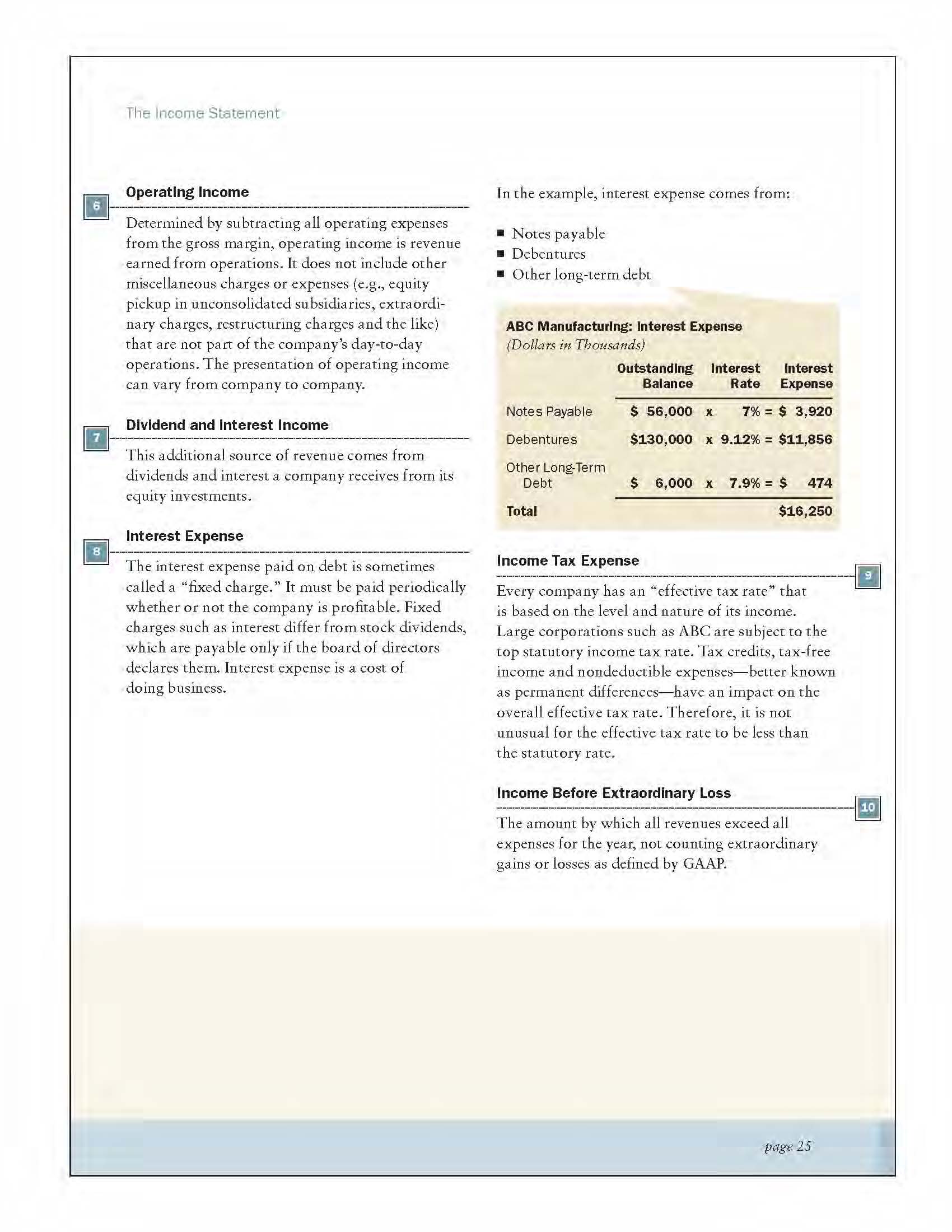
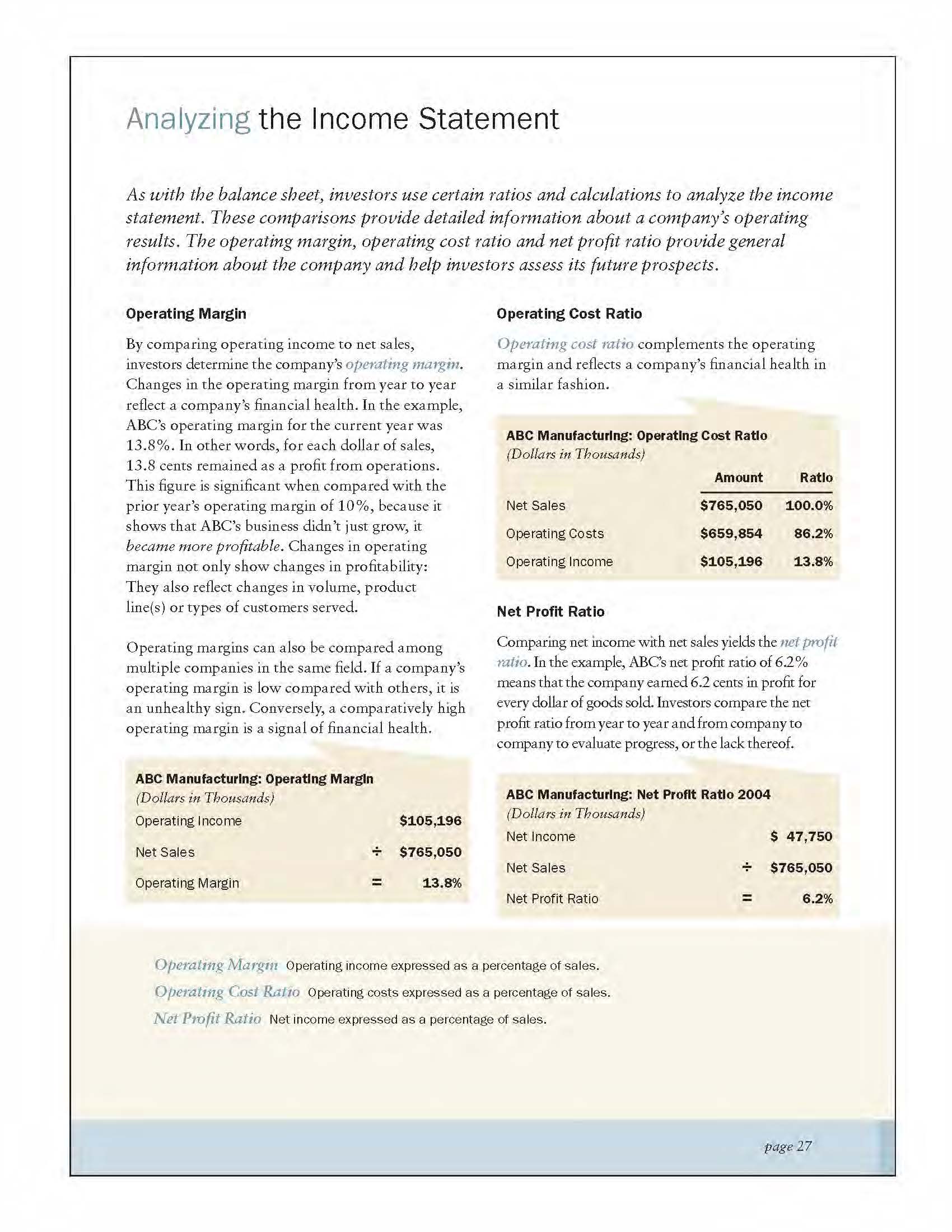

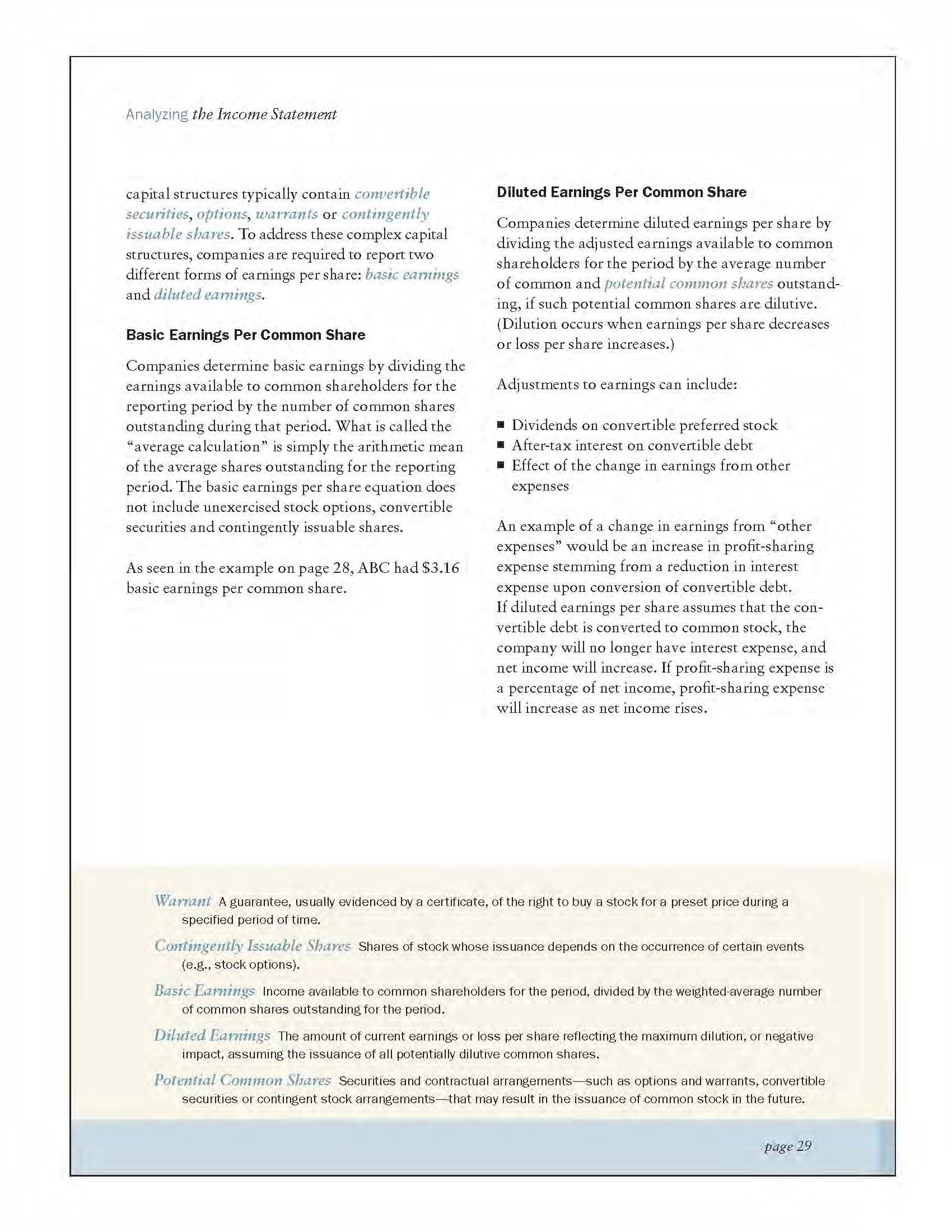
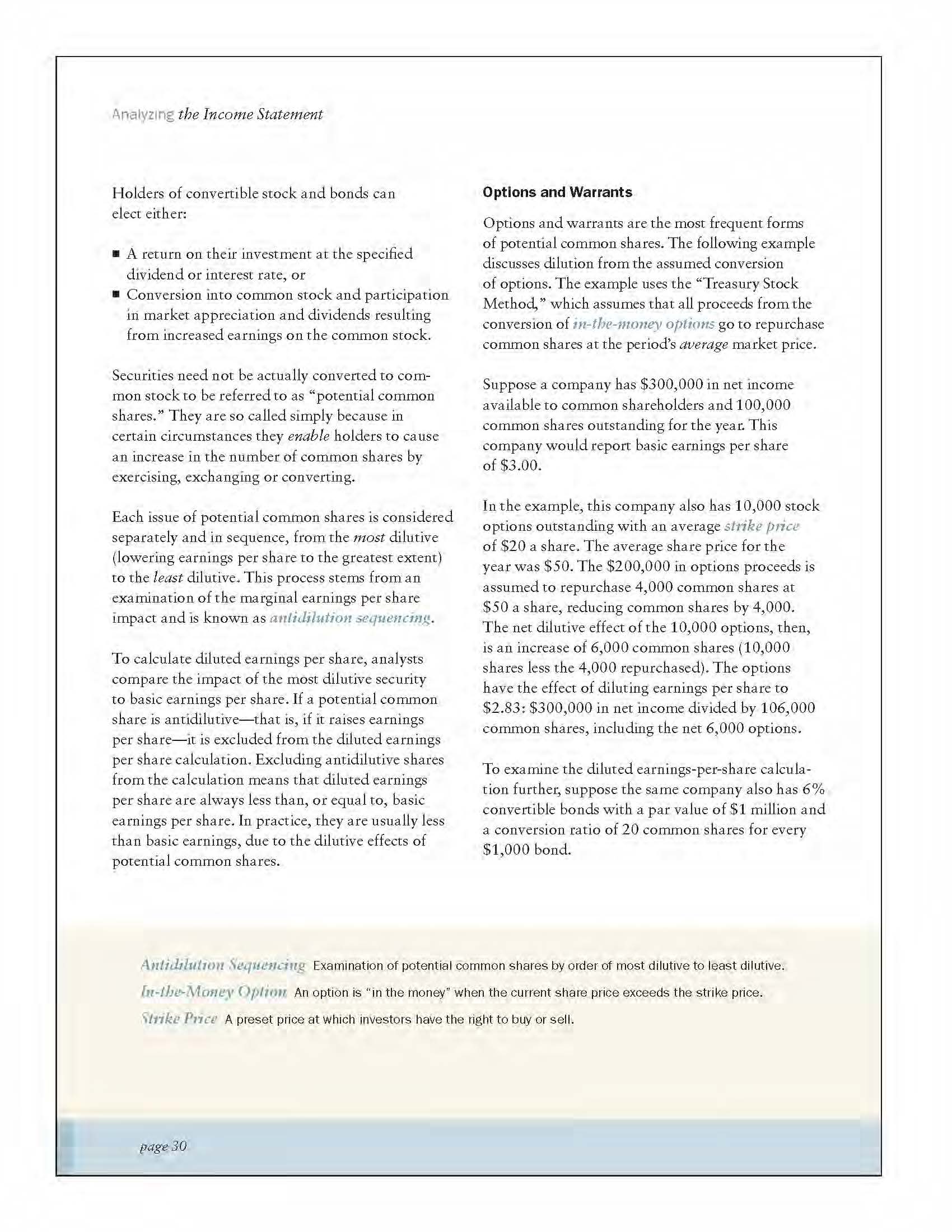
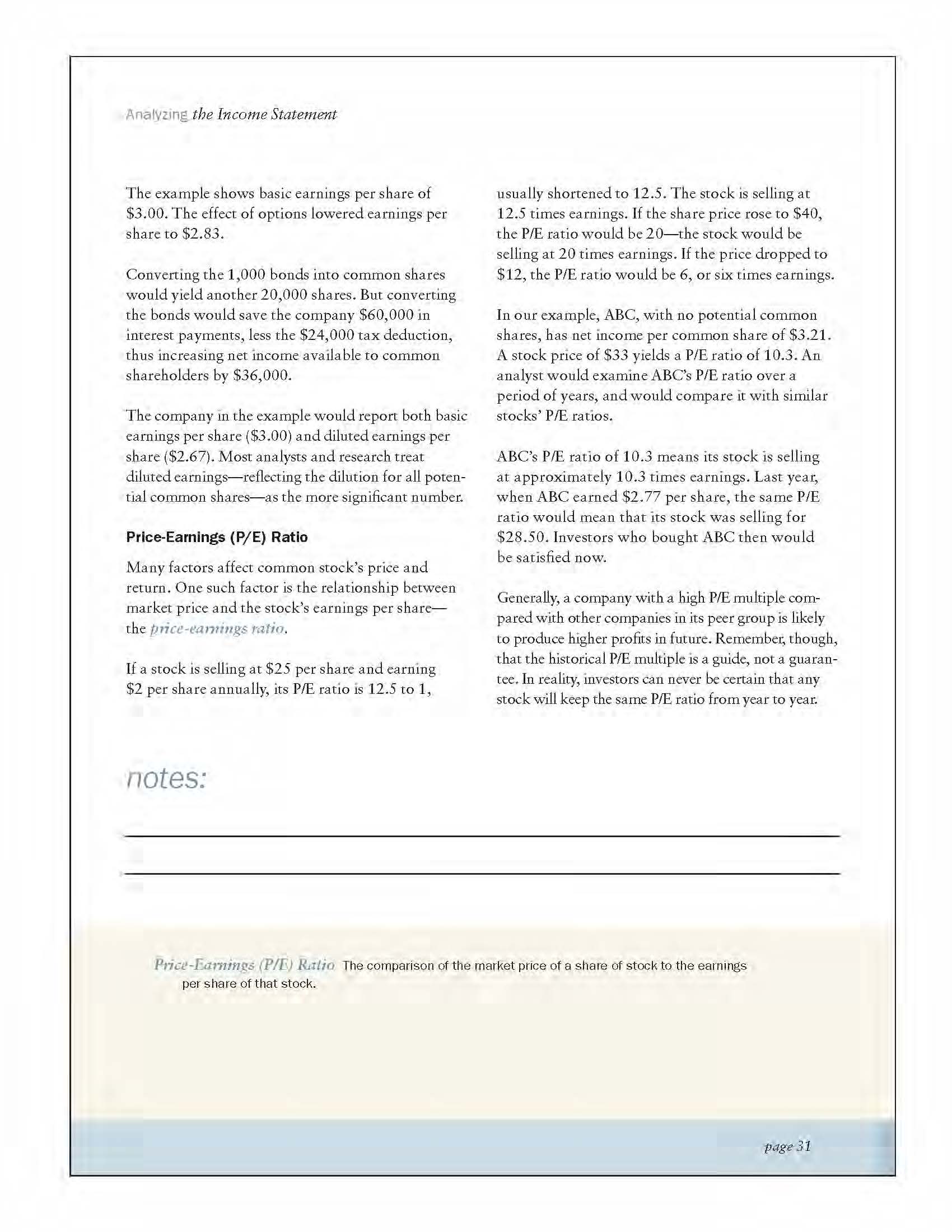
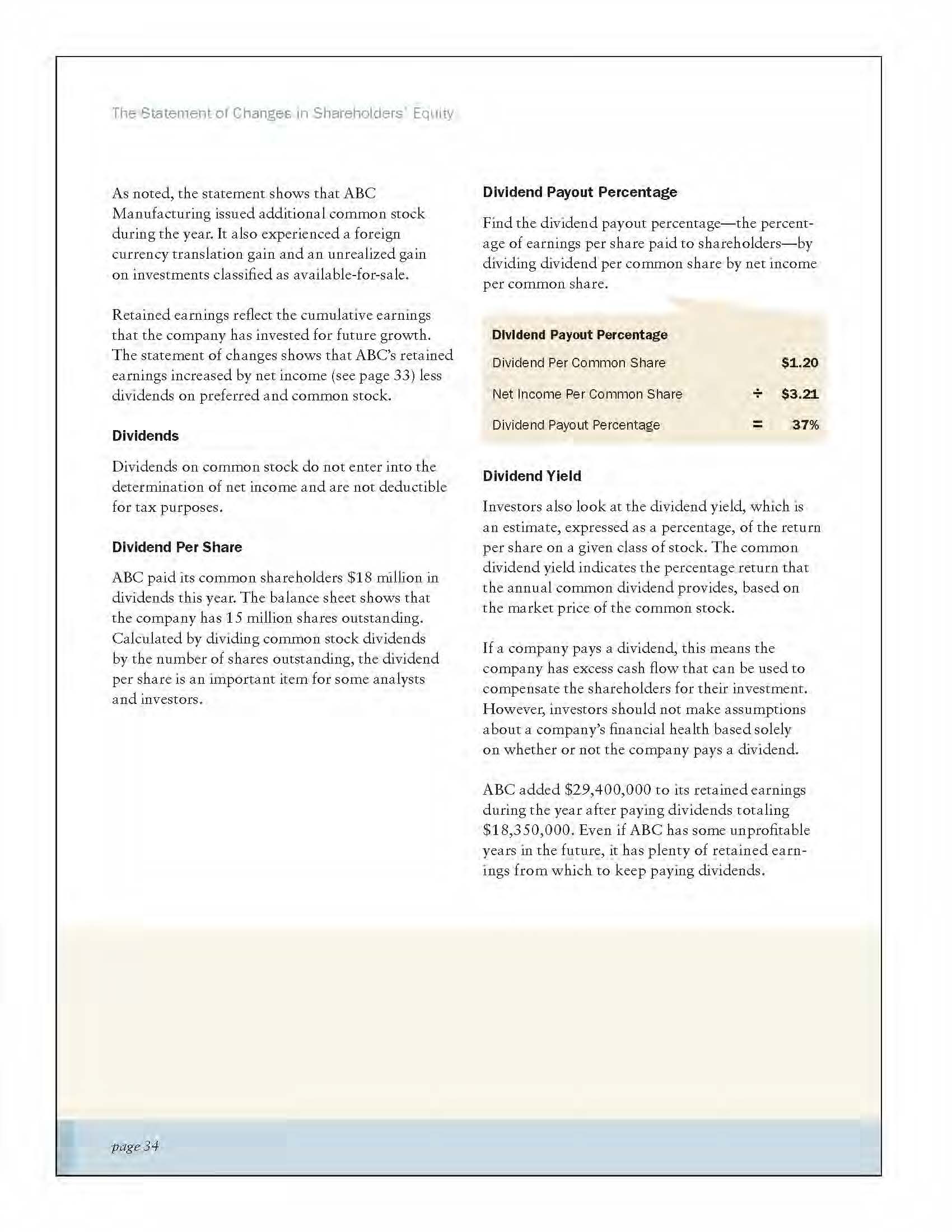
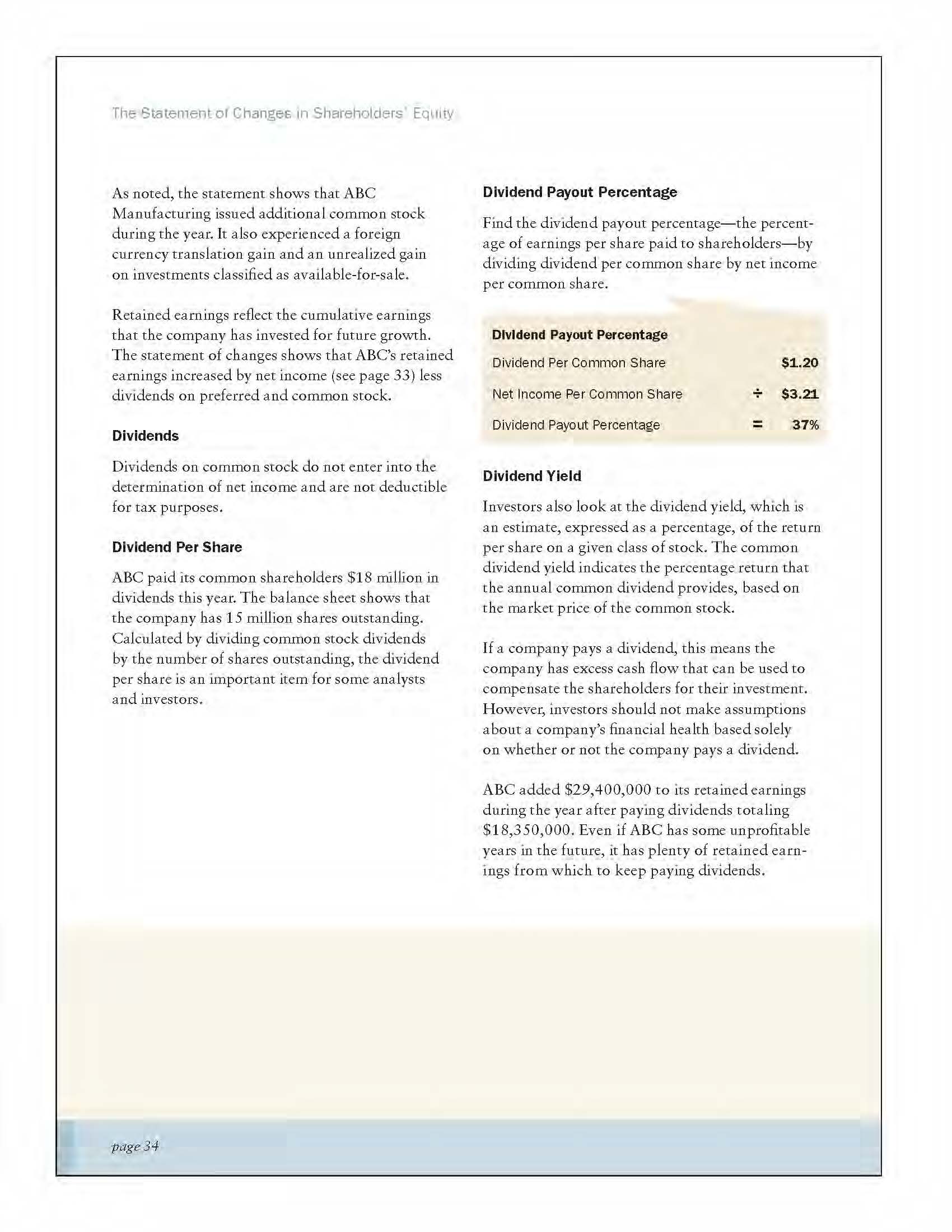

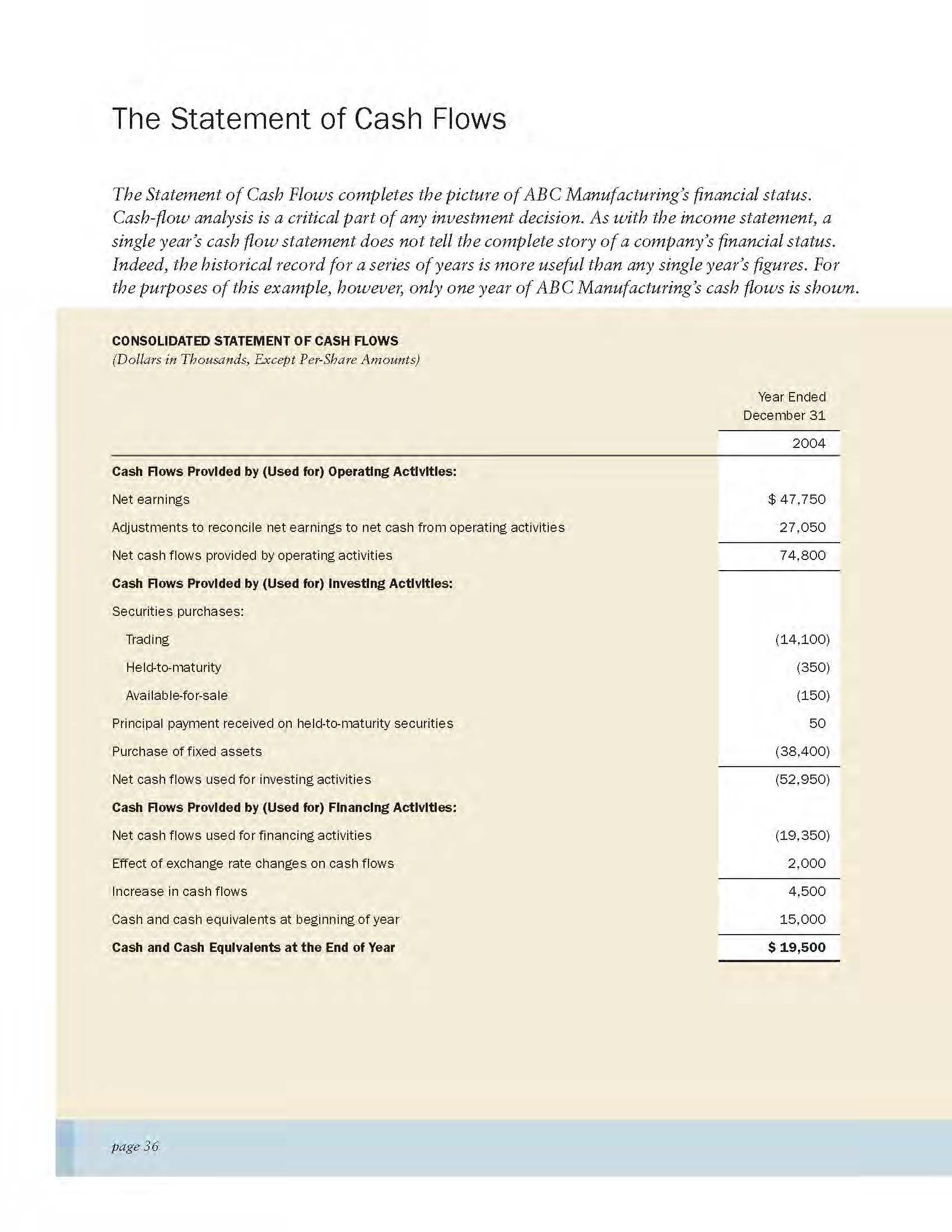


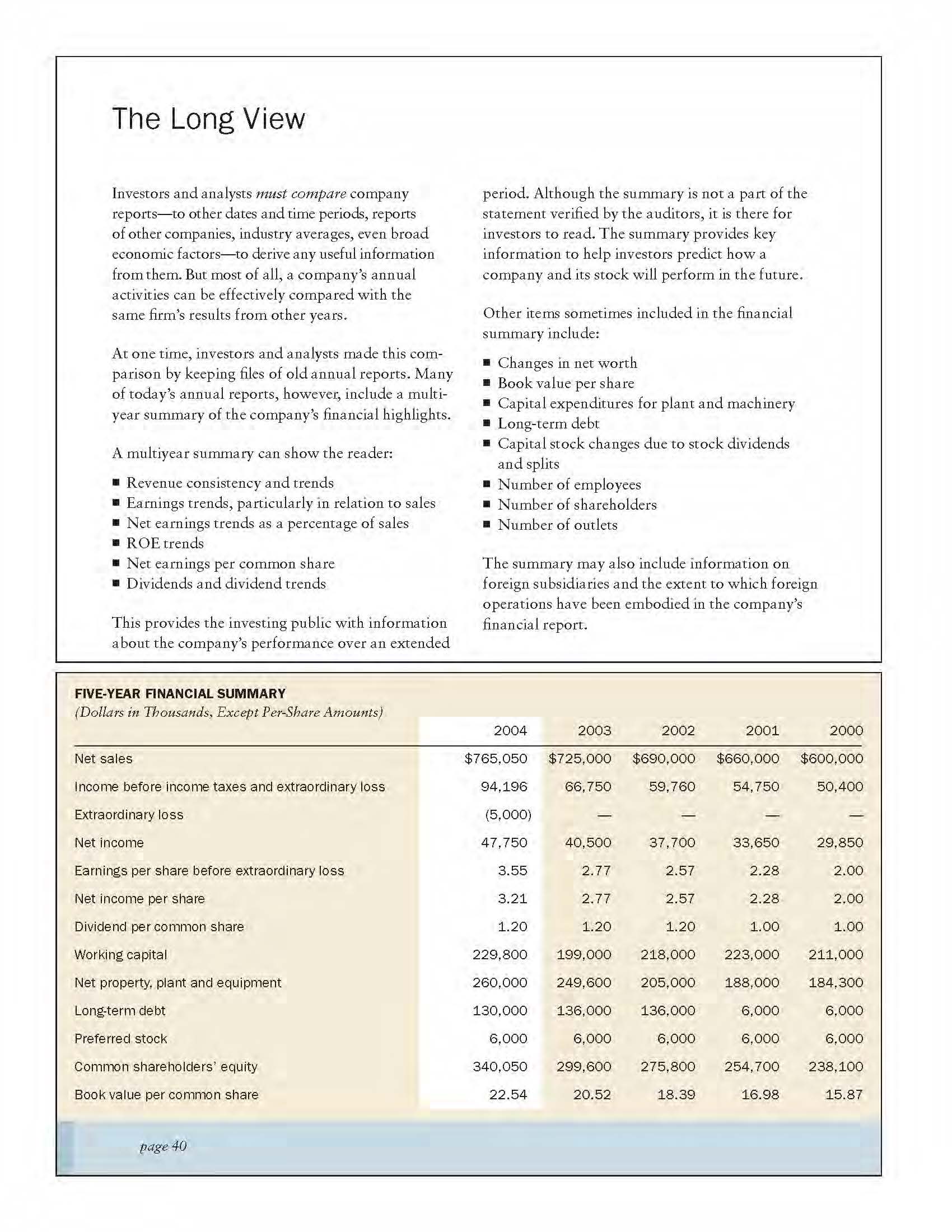
The Balance Sheet: Assets The assets section includes all the goods and property owned by the company, as well as uncollected amounts, called "receivables," that are due to the company from others. Like the other sections of the financial statements, this section is subdivided into line items, or groups of similar "accounts" having a dollar amount or "balance." Note Line items are numbered to facilitate the discussion on the following pages. The Income Statement The income statement for a single year does not tell a complete story. Indeed, the historical record for a series of years is more important than any single year's figures. In the example, ABC Manufacturing includes two years in its income statement and also provides a five-year financial summary (discussed in detail on pages 40-41). CONSOLIDATED INCOME STATEMENTS (Dollars in Thousands, Except Per-Share Amounts) A healthy stockpile of retained earnings gives a company a cushion against hard times, but they can also spark a hostile takeover attempt. Another company could buy enough of ABC 's common shares to vote out the current management and merge ABC into itself. The acquiring company could get the money to buy ABC 's stock by issuing shares of its own stock, then use ABC 's retained earnings to pay the dividends. This possibility makes it incumbent upon ABC's management to ensure that its retained earnings are put to work to increase the company's total wealth. Otherwise, the shareholders might cooperate in the raid on ABC. Return on Equity (ROE) Return on equity shows how hard shareholders' equity is working. ROE is a popular measure for investors making individual judgments on how much a certain stock is worth. To compute ABC's ROE, look at the balance sheet and compute the average common shareholders" equity for the year to find how much ABC made on it. This means that for every dollar of shareholders' equity, ABC earned nearly 15 cents. In considering how good a return this is-and, by extension, whether to put money to work in ABC's stockinvestors must: - Compare ABC's 14.8% with ROE from ABC's competitors - Compare ABC 's return with the potential return from other investments; e.g., CDs, corporate bonds, real estate or other common stocks. Note that 14.8% is what ABC itself earns and by no means reflects what investors will receive in dividends on ABC's stock. What ROE really reveals is whether ABC. Manufacturing is a relatively attractive investment. If so, investors can only hope that this attractiveness will be reflected in ABC's share price. Dividend yield shows how much the company actually paid out to shareholders in cash (as a dividend), compared with the current market price of the stock. The Balance Sheet: Liabilities and Shareholders' Equity As noted, the Liabilities and Shareholders' Equity section details what the company owes. This includes obligations to its regular business creditors, banks, individuals, and other corporations; accrued expenses; taxes; and loans and other debt obligations. Like the other sections of the financial statements, it is subdivided into line items or groups of similar "accounts" having a dollar amount or "balance." Consolidated Financial Statements: The Key Components This page shows the key components of the basic financial statements of an imaginary company, ABC Manufacturing. Annual financial statements are usually stated at historical cost and are accompanied by an independent auditors' report, which is why they are called "audited" financial statements. operations resulted in a profit or a loss. Audit A systematic examination of a company's financial statements to determine if the amounts and disclosures in the reports are fairly stated and follow generally accepted accounting principles, or GAAP. Dividends Payments to shareholders as a return on their investment. Generally Accepted Accounting Principles (GAAP) The rules and standards followed in recording transactions and in preparing financial statements. Historical Cost Assets are reported as the amount of cash or cash equivalents paid to purchase them, and liabilities are reported as the amount of cash and cash equivalents received when the obligation was incurred. Analyzing the Balance Sheet Quick Assets Ratio The quick assets ratio offers another way to determine the adequacy of working capital. Quick assets are those current assets that can quickly be converted to cash. To find the quick assets ratio, divide quick assets by current liabilities. Based on this example, if the company could liquidate its quick assets immediately, it would have the ability to pay off its current liabilities 1.26 times. A well-positioned company should show a reasonable excess of net quick assets, or quick assets over current liabilities. The lack of positive net quick assets would demonstrate a company's potential inability to meet current liabilities. Debt-to-Equity Ratio The debt-to-equity ratio indicates whether a company is using debt responsibly. In the example, ABC's debt-to-equity ratio of 93 means the company is using 93 cents of liabilities for every dollar of shareholders' equity in the business. Industrial companies normally try to maintain a debt-to-equity ratio of less than 1:1-thereby keeping debt at a level below the owners' investment level. Utilities, service companies and financial companies often operate with much higher ratios. Quick Assets Assets that can be quickly converted into cash to cover a sudden emergency. Calculated by subtracting inventories, prepaid expenses and any other illiquid current assets from total current assets. Excludes merchandise inventories, which must be sold and are not quickly convertible into cash. Net Quick Assets Found by subtracting total current liabilities from quick assets. Debt-to-Equity Ratio Total liabilities divided by total shareholders' equity. Because the income statement shows how much a company earned or lost during the year, many analysts, investors and potential investors consider it the most important report available. An income statement matches the revenues earned from selling goods and services, or from other activities, against all costs and outlays incurred in the operation of the company. The difference is the net income (or loss) for the year. Net Income The difference between revenues and outlays for the year. Costs Incurred Usually consists of cost of sales and selling, general and administrative expenses (e.g., wages and salaries, rent, supplies, depreciation, interest on money borrowed, and taxes). Why is the income statement of such great interest to investors? There are two main reasons: It shows the record of a company's operating results for the whole year (unlike the balance sheet, which is a snapshot of the company's financial position at a specific point in time, showing what the company owns and what it owes at the report date). It can be used to gauge a company's potential future performance. The Long View Investors and analysts must compare company reports - to other dates and time periods, reports of other companies, industry averages, even broad economic factors - to derive any useful information from them. But most of all, a company's annual activities can be effectively compared with the same firm's results from other years. At one time, investors and analysts made this comparison by keeping files of old annual reports. Many of today's annual reports, however, include a multiyear summary of the company's financial highlights. A multiyear summary can show the reader: - Revenue consistency and trends - Earnings trends, particularly in relation to sales - Net earnings trends as a percentage of sales - ROE trends - Net earnings per common share - Dividends and dividend trends This provides the investing public with information about the company's performance over an extended period. Although the summary is not a part of the statement verified by the auditors, it is there for investors to read. The summary provides key information to help investors predict how a company and its stock will perform in the future. Other items sometimes included in the financial summary include: - Changes in net worth - Book value per share - Capital expenditures for plant and machinery - Long-term debt - Capital stock changes due to stock dividends and splits - Number of employees - Number of shareholders - Number of outlets The summary may also include information on foreign subsidiaries and the extent to which foreign operations have been embodied in the company's financial report. Net Sales A company's primary revenue source usually appears first on the income statement. In the example, the "net sales" item includes the amount reported after taking into consideration returned goods and allowances for price reductions or discounts. A year-to-year comparison of net sales indicates whether sales are increasing or decreasing. Cost of Sales Commonly known as product costs, these are all the costs a company incurs to purchase and convert raw materials into the finished products that it sells. Product costs have three basic components: - Direct materials - Direct labor - Manufacturing overhead The first two items can be directly linked to the finished product. For a furniture manufacturer, for example, lumber is a direct material cost and carpenters' wages are a direct labor cost. Manufacturing overhead differs from the other two components in that it cannot be linked directly to a single finished product. Examples include general operating costs such as rent, electricity, supplies, depreciation, maintenance and repairs, and the salaries of production workers. The precise definition of direct costs varies from industry to industry. Generally, however, they are those costs that can be linked directly to the revenues earned from a product or service. Gross Margin Defined as "the excess of sales over cost of sales," gross margin represents the actual direct profit from sales after considering product costs. Analysts and investors compare gross margin trends from year to year in assessing companies' financial health. They also compare the gross margin percentage from year to year. Depreciation and Amortization Captures each year's decline in value. As shown here, amortization reports the year's decline in value of intangibles. A 17-year patent, for example, would be a mortized over a period of 17 years using the straight-line method of a mortization. Selling, General and Administrative Expenses Includes expenses such as sales agents' salaries and commissions, advertising and promotion, travel and entertainment, executives' salaries, office payroll, and office expenses. This item is kept separate so that analysts and investors can see the extent of sales and administrative costs. Product Costs Those costs that can be identified with the purchase or manufacture of goods made available for sale. Gross Maryin Percentage Gross margin divided by net sales. Analyzing the Income Statement As with the balance sheet, investors use certain ratios and calculations to analyze the income statement. These comparisons provide detailed information about a company's operating results. The operating margin, operating cost ratio and net profit ratio provide general information about the company and help investors assess its future prospects. Operating Margin By comparing operating income to net sales, investors determine the company's openating mangin. Changes in the operating margin from year to year reflect a company's financial health. In the example, ABC's operating margin for the current year was 13.8%. In other words, for each dollar of sales, 13.8 cents remained as a profit from operations. This figure is significant when compared with the prior year's operating margin of 10%, because it shows that ABC's business didn't just grow, it became more profitable. Changes in operating margin not only show changes in profitability: They also reflect changes in volume, product line(s) or types of customers served. Operating margins can also be compared a mong multiple companies in the same field. If a company's operating margin is low compared with others, it is an unhealthy sign. Conversely, a comparatively high operating margin is a signal of financial health. Operating Cost Ratio Operating cost ratio complements the operating margin and reflects a company's financial health in a similar fashion. ABC Manufacturing: Operating Cost Ratlo (Dollars in Thousands) Net Profit Ratio Comparing net income with net sales yields the net profif ratio. In the example, ABC 's net profit ratio of 6.2% means that the company earned 6.2 cents in profit for every dollar of goods sold. Investors compare the net profit ratio from year to year and from company to company to evaluate progress, or the lack thereof. Operating Margini Operating income expressed as a percentage of sales. Operating Cost Ratio Operating costs expressed as a percentage of sales. Net Profit Ratio Net income expressed as a percentage of sales. This section of the balance sheet represents ABC Manufacturing's assets at the end of one particular day, December 31, 2004. The company's assets for the previous year end are also presented, making it possible to compare the balance sheets for those dates. Current Assets In general, current assets include cash and other assets that, in the normal course of business, will be turned into cash within a year from the balance sheet date. These other assets primarily include marketable securities, accounts receivable, inventories and prepaid expenses. Current assets are listed on the balance sheet in order of their "liquidity," i.e., the amount of time it takes to convert these assets into cash. Current assets are "working" assets in the sense that they are liquid-they can, and will, be converted into cash for other business purposes, or be consumed in the business. Inventories, when sold, become accounts receivable; receivables, upon collection, become cash; the cash can then be used to pay the company's debt and operating expenses. Cash and Cash Equivalents Money on deposit in the bank, cash on hand (petty cash) and highly liquid securities such as Treasury bills. Marketable Securities Short-term securities that are readily salable and usually have quoted prices. May include: - Trading securities-debt and equity securities, bought and sold frequently, primarily to generate short-term profits, and carried at fair makket value. Any changes in such values are included in the statement of earnings as unrealized gains and losses from trading activities. - Held-to-maturity securities-debt securities that the company has the ability and intent to hold to maturity, i.e., the date when debt instruments, such as Treasury bills, are due and payable. These securities are reported at amortized cost (their original cost, adjusted for changes in any purchase discount or premium, less any principal payments received). - Available-for-sale securities-debt or equity securities not classified as either trading or heldto-maturity. They are recorded at fair value, with changes in such values included as a component of other comprehensive income as unrealized gains and losses from available-for-sale securities. ABC Manufacturing owns short-term, high-grade commercial paper, classified as "trading securities," as well as preferred stock, classified as "available for sale." ABC, however, has no short-term "heldto-maturity" securities. Farr Markot Value The amount at which an item could be exchanged between willing unrelated parties, other than in a forced liquidation. It is usually the quoted market price when a market exists for the item. are paid to the common shareholders. "Cumulative" means that if in any year the dividend is not paid, it continues to grow in favor of preferred shareholders. The company must declare total unpaid dividends and pay them to preferred shareholders when available, before paying any dividends on the common stock. Even though preferred shareholders are entitled to dividends before common shareholders, their entitlement is generally limited-to $5.83 per share annually in ABC's case. Generally, preferred shareholders have no voice in company affairs unless the company fails to pay them dividends at the promised rate. Common Stock Unlike preferred stock, common stock has no limit on dividends payable each year. When earnings are high, dividends may also be high. When earnings drop, so may dividends. In the example, ABC 's common stock has a par value of $5.00 a share. In 2004 , the company sold 500,000 shares of stock for a total of $9,000,000. Of the $9,000,000,$2,500,000 is reported as common stock-500,000 shares at a par value of $5.00. The balance of $6,500,000 is reported as additional paid-in capital (discussed below). When added to the prior year-end common stock balance of $72,500,000, the $2,500,000 brings the common stock balance to $75,000,000. Additional Paid-In Capital As noted, paid-in capital increased by $6,500,000 in 2004. When added to last year's ending balance of $13,500,000, this amount brings additional paid-in capital at December 31,2004 , to a total of $20,000,000. Retained Earnings When a company first starts in business, it has no retained earnings. Retained earnings are accumulated profits that the company "retains"-i.e., earns and reinvests in the company. Retained earnings increase by the amount of profits earned, less dividends declared and/or paid to shareholders. In the example below, profits at the end of 2003 were $40,500,000. The company paid no dividendsso the balance sheet shows retained earnings of $219,600,000. Profits at the end of 2004 were $47,750,000; the company paid dividends of $350,000 on the preferred and $18,000,000 on the common-so retained earnings totaled $249,000,000. Addilional Paid-In Capital. The amount paid by shareholders in excess of the par, or stated value, of each share. The Balance Sheet: Assets Deferred Charges Expenditures for items that will benefit future periods more than one year from the balance sheet date. Costs of debt issuance would be one example of a deferred charge. Deferred charges are similar to prepaid expenses, but are not included in current assets because their benefits will be realized in periods more than one year from the balance sheet date. The cost incurred will be gradually expensed over the asset's future benefit period(s), not fully charged off in the year payment is made. Intangibles Assets having no physical existence that nonetheless have substantial value to the company. Examples include a patent for exclusive manufacture of an item, a franchise allowing exclusive service in a specific area, a trademark or a copyright. Goodurlf is a nother intangible asset found on the balance sheet. It is presumed to represent the value of the company's name, reputation, customer base, intellectual capital and workforce. Intangible assets reported on the balance sheet are generally those purchased from others. They are a mortized over their estimated useful lives, but usually not longer than 40 years. In the standard accounting model, Net Intangible Assets = Intangible Assets - Accumulated Anonization. Accumulated amortization is the total amount of the periodic charges against income. Investment Securities, at Cost Investments in debt securities are carried at amortized cost only when the company has the ability and intent to hold them to maturity. In the example, early in 2004, ABC Manufacturing purchased mortgage bonds issued by one of its major suppliers. The bonds are due in full in five years and bear annual interest of 8%. In 2004, the issuer made an unscheduled principal prepayment of $50,000. Since ABC intends to maintain a continuing relationship with the issuer and to hold the bonds until they mature - and appears to have the financial strength to do so-this investment is classified as "held-tomaturity," and therefore the $50,000 prepayment would reduce the cost of the debt security. All investments of this type must be reviewed to ensure that all cont ractually specified amounts are fully collectible. If not fully collectible, an investment would be considered permanently imparred, and it would be necessary to write it down to its fair value. In the example, however, the issuer is in a strong financial condition, as shown by: - The issuer's unscheduled prepayment of principal. - Increased property values where the plant that secures the bonds is located. Thus, there is no reason to suspect that all contractual amounts will not be collected. There is no impairment, and no required write-down in investment security value. Goodurill The amount by which the price of an acquired company exceeds the fair value of the related net assets acquired. It is presumed to represent the value of the company's name, reputation, customer base, intellectual capital and workforce. Anontization Periodic charges to income to recognize the allocation of the cost of the company's intangible assets over the estimated useful lives of those assets. Permanent Lmpainnemt The probability that the investor will not collect all amounts in accordance with the loan agreement. The Balanoe Sheet: Liabilities and Sharebolders' Equity Had ABC realized net losses over the years and had a negative retained earnings balance, the accumulated losses would be reported as an "accumulated deficit." Foreign Currency Translation Adjustments (Net of Taxes) Companies with ownership interests in foreign entities may be required to include those entities' results in the consolidated financial statements. In such cases, the foreign entities' financial statements must be translated into U.S. dollars. The gain or loss resulting from this translation, net of taxes, is reflected as a separate component of shareholders' equity. These adjustments are distinct from conversion gains or losses related to completed transactions denominated in foreign currencies. Such "conversion gains or losses" are included in a company's net income. Unrealized Gain on Available-for-Sale Securities (Net of Taxes) This item represents the change in value (gain or loss) of "available-for-sale" securities that the company is still holding. In the example, this represents the difference between the cost of these securities and their fair market value at the date of the balance sheet. The difference-a gain, in the example - has not yet been realized because ABC has not sold the securities yet. This unvealized amount is not included as part of current income. But because ABC must report these securities at their fair market value, the company must also report the changes in that value, net of taxes, as a separate component of shareholders' equity. In the example, the total fair market value of available-for-sale securities exceeded their cost by $65,000. This increase in value increased taxes by $15,000, resulting in a net unrealized gain of $50,000. Treasury Stock When a company buys its own stock back, that stock is recorded at cost and reported as "treasury stock" - so called because it is returned to the company's treasury. Treasury stock is not an asset, and is reported as a deduction from shareholders' equity. Gains or losses from the sale of such shares are reported as adjustments to shareholders' equity, and are not included in income. notes: Net of Toxes A value or amount that has been adjusted for the effects of applicable taxes. Untealized Anounts Changes in the fair value of assets held that are not recorded in the income statement. The Balance Sheet: Assets Accounts Receivable The amounts due from customers but not yet collected. When goods are shipped to customers before payment or collection, an account receivable is created whereby customers are generally given an agreed-upon time period in which to paynormally 30,60 or 90 days. In this example, the total amount due from customers is $158,375,000. Experience shows, however, that some customers fail to pay their bills, which means it is unlikely that the entire balance recorded as due and receivable will be collected. Therefore, in order to show the accounts receivable balance as a figure representing expected receipts, an allowance for doubiful accounts is deducted from the total amount recorded. In this instance, the allowance for doubtful accounts is $2,375,000. Inventories A manufacturing company's inventory consists of quantities of physical products assembled from various materials, which fall into one of the three following categories: - Raw materials - items to be used in making a product (e.g., the fabric used in making a blouse). -Work-in-process-partially completed goods in the process of manufacture (e.g., pieces of fabric such as a sleeve and cuff sewn together during the process of making a blouse). - Finished goods-completed items ready for their intended use. The amount of each of these types of inventories is generally disclosed either on the face of the balance sheet or in the notes. For ABC, inventory represents the cost of items on hand that were purchased and/or manufactured for sale to customers. To provide a conservative figure, inventories are valued using the lower of cast or market mule. For balancesheet purposes, the lower of the two will usually be cost; however, if the market price is lower due to deterioration, obsolescence, declining prices or other factors that are expected to result in the selling or disposing of inventories below cost, the market price is used. The value of finished goods includes the direct costs of purchasing the materials used to produce the company's products, as well as an allocation (i.e., an apportionment or dividing up) of the production expenses required to make those products. To do this, manufacturers use "cost accounting," a specialized set of accounting procedures focusing on specific products, to determine individual product costs. When the individual direct costs for manufactured inventory are added up, they comprise the value of finished goods. Allowance for Doubtful Acconsuts. Amounts deducted from the total accounts receivable balance as a way of recognizing that some customers will not pay what they owe. Also called Provision for Doubiful Accounts, Reserve for Doubtful Accounts or Bad Debt Reserve. Lower of Cost or Markel Rule A rule providing that inventories be valued at either their cost or market value, whichever is lower. The intent is to provide a conservative figure in valuing a company's inventories. Analyzing the Income Statement Holders of convertible stock and bonds can elect either: - A return on their investment at the specified dividend or interest rate, or - Conversion into common stock and participation in market appreciation and dividends resulting from increased earnings on the common stock. Securities need not be actually converted to common stock to be referred to as "potential common shares." They are so called simply because in certain circumstances they enable holders to cause an increase in the number of common shares by exercising, exchanging or converting. Each issue of potential common shares is considered separately and in sequence, from the most dilutive (lowering earnings per share to the greatest extent) to the least dilutive. This process stems from an examination of the marginal earnings per share impact and is known as antidilution sequencins. To calculate diluted earnings per share, analysts compare the impact of the most dilutive security to basic earnings per share. If a potential common share is antidilutive-that is, if it raises earnings per share-it is excluded from the diluted earnings per share calculation. Excluding antidilutive shares from the calculation means that diluted earnings per share are always less than, or equal to, basic earnings per share. In practice, they are usually less than basic earnings, due to the dilutive effects of potential common shares. Options and Warrants Options and warrants are the most frequent forms of potential common shares. The following example discusses dilution from the assumed conversion of options. The example uses the "Treasury Stock Method," which assumes that all proceeds from the conversion of in-the-money options go to repurchase common shares at the period's average market price. Suppose a company has $300,000 in net income available to common shareholders and 100,000 common shares outstanding for the year. This company would report basic earnings per share of $3.00. In the example, this company also has 10,000 stock options outstanding with an average strike price of $20 a share. The average share price for the year was $50. The $200,000 in options proceeds is assumed to repurchase 4,000 common shares at $50 a share, reducing common shares by 4,000 . The net dilutive effect of the 10,000 options, then, is an increase of 6,000 common shares (10,000 shares less the 4,000 repurchased). The options have the effect of diluting earnings per share to $2.83:$300,000 in net income divided by 106,000 common shares, including the net 6,000 options. To examine the diluted earnings-per-share calculation further, suppose the same company also has 6% convertible bonds with a par value of $1 million and a conversion ratio of 20 common shares for every $1,000 bond. Antiditution Sequencing Examination of potential common shares by order of most dilutive to least dilutive. In-1he-Money Oplion An option is "in the money" when the current share price exceeds the strike price. Srike Price A preset price at which investors have the right to buy or sell. The Statement of Cash Flows The Statement of Cash Flows completes the picture of ABC Manufacturing's financial status. Cash-flow analysis is a critical part of any investment decision. As with the income statement, a single year's cash flow statement does not tell the complete story of a company's financial status. Indeed, the historical record for a series of years is more useful than any single year's figures. For the purposes of this example, however, only one year of ABC Manufacturing's cash flows is shown. CONSOLIDATED STATEMENT OF CASH FLOWS (Dollars in Thousands, Except Per-Share Amounts) Additional Disclosures and Audit Reports Notes Many people do not like to read the notes to an annual report because they are complicated and are rarely written in plain English. Yet the notes reveal many critical aspects of a company's financial story. For example, notes contain a number of important and required disclosures. Bear in mind that the financial statements themselves just report the balances in the various accounts and do not contain a complete or adequate discussion of those balances. The information in the notes can highlight the reasons the balances came out as they did. Typically included in the notes are the following: - Description of the company's policies-for depreciation, amortization, consolidation, foreign currency translation, earnings per share, etc. - Inventory valuation method -indicates which method is used to determine the cost of goods sold on the income statement and on the balance sheet. In addition to average cost, examples of valuation methods include lastint first-out (LIFO) and firstin, first-out (FIFO). LIFO means that the costs on the income statement reflect the cost of inventories produced or purchased most recently; FIFO reflects the costs of the oldest inventories. This distinction is extremely important: LIFO does not overstate profits during inflationary times, while FIFO does. - Inventory composition - the composition of the inventories by raw materials, work-in-process, finished goods and supplies. Inventory composition is usually not shown on the balance sheet. - Asset impairment-details about impaired assets or assets to be disposed of. - Investments-information about debt and equity securities classified as "trading," "available for sale" or "held to maturity." - Income tax provisions - the breakdown by current and deferred taxes and its composition into federal, state, local and foreign tax, accompanied by a reconciliation from the statutory income tax rate to the effective tax rate for the company. - Changes in accounting policy-changes in accounting policy due to new accounting rules. - Nonrecuring items-details of items such as pension-plan terminations or acquisitions/ dispositions of significant business units. - Employment and retirement programsdetails of employment contracts, profit-sharing, pension and retirement plans and other postretirement, postemployment benefits. - Stock options-details of stock options granted to officers and employees. - Long-term leases-disclosure of lease obligations on assets and facilities on a per-year basis for the next several years, as well as total lease obligations over the remaining lease period. List-Int, Firsl-Ow (LIFO) An inventory-costing method that states inventory at its earliest cost while charging cost of sales at its latest cost (in the reverse order that the inventory was accumulated). First-In, First-Owf (FIFO) An inventory-costing method that states inventory at its current cost while charging cost of sales in the order that the inventory was accumulated. make any payments on the note until 2005 , the balance due has been included in "other long-term debt" in prior years. As of December 31, 2004, the $6,000,000 due at maturity is payable within 12 months and therefore has been reclassified as "current portion of long-term debt" in the December 31, 2004 balance sheet. Accrued interest is not included in the debt balance. Long-Term Liabilities Amounts due after 12 months from the date of the balance sheet are grouped under Long-Term Liabilities. Unfunded Retiree Benefit Obligations The difference between the accumulated benefit obligation of an employer to its retirees and the current fair value of the benefit plan assets. Deferred Income Taxes These are tax liabilities a company will be required to pay at some future date. (Deferred income tax: assets are tax assets a company will receive at some future period.) The government offers tax incentives for certain kinds of investments that it believes will benefit the economy as a whole. For example, a company can take accelerated depreciation deductions on its tax returns for investing in plant and equipment while using less rapid, more conventional depreciation for financial reporting purposes. Accelerated depreciation deductions in the early years of an investment reduce the amount of tax the company would otherwise currently owe (within 12 months) and allow the company to defer payment into the future (beyond 12 months). Because the taxes must eventually be paid, companies include a charge for deferred taxes in their provision for tax expense on the income statement. The liability for that charge is reported as deferred income taxes-i.e., taxes due at a future date. Long-Term Debt The second long-term liability item on ABC's balance sheet is 9.12% debeniures due in 2010 . Money was received by the company as a loan from bondholders, who in turn were given certificates called bonds as evidence of the loan. These bonds are formal promissory notes issued by the company. ABC will pay interest on the loan at an annual rate of 9.12%, and repay the principal at maturity in 2010. Because the bonds are backed only by the company's general credit, they are known as debentures. Companies also issue secured debt (e.g., mortgage bonds). These instruments offer bondholders an added safeguard because they are secured by a mortgage on all or some of the company's property, meaning that the assets may be sold and the proceeds used to satisfy the debt. If the company is unable to pay the bonds when they are due, holders of mortgage bonds have a claim or lien before other creditors, such as debenture holders. Long-Tenn Liabilities Amounts due after one year from the date of the financial report. Deferred Incone Tax Assets Future income tax credits recognized in advance of actually receiving them. Accelerated Depreciation Deductions IRS rules allow specific assets to be depreciated at a higher rate during the first few years of usage, instead of depreciating evenly over the asset's useful life. Debentures Formal, unsecured debt obligations (bonds or notes) backed only by the general credit of the issuer rather than certain of its assets. Bonds Formal, secured or unsecured debt obligations with specified interest and repayment terms. The Balance Sheet: Liabilities and Shareholders' Equity The balance sheet is always divided into two halves: Assets and Liabilities, and Shareholders' Equity. The two halves should always be in balance. From an economic viewpoint, each dollar of assets must be offset by a dollar of liabilities or shareholders' equity. Liabilities and Shareholders' Equity The Liabilities and Shareholders' Equity section of the balance sheet details what the company owes. This section always appears to the right of, or below, the Assets section of the balance sheet. Remember that, in the standard accounting model, Assets = Liabilities + Shareholders' Equity. As noted, the statement shows that ABC Manufacturing issued additional common stock during the year. It also experienced a foreign currency translation gain and an unrealized gain on investments classified as available-for-sale. Retained earnings reflect the cumulative earnings that the company has invested for future growth. The statement of changes shows that ABC's retained earnings increased by net income (see page 33 ) less dividends on preferred and common stock. Dividends Dividends on common stock do not enter into the determination of net income and are not deductible for tax purposes. Dividend Per Share ABC paid its common shareholders $18 million in dividends this year. The balance sheet shows that the company has 15 million shares outstanding. Calculated by dividing common stock dividends by the number of shares outstanding, the dividend per share is an important item for some analysts and investors. Dividend Payout Percentage Find the dividend payout percentage - the percentage of earnings per share paid to shareholders-by dividing dividend per common share by net income per common share. Dividend Yield Investors also look at the dividend yield, which is an estimate, expressed as a percentage, of the return per share on a given class of stock. The common dividend yield indicates the percentage return that the annual common dividend provides, based on the market price of the common stock. If a company pays a dividend, this means the company has excess cash flow that can be used to compensate the shareholders for their investment. However, investors should not make assumptions about a company's financial health based solely on whether or not the company pays a dividend. ABC added $29,400,000 to its retained earnings during the year after paying dividends totaling $18,350,000. Even if ABC has some unprofitable years in the future, it has plenty of retained earnings from which to keep paying dividends. Introduction: About This Guide One might assume that of the two sections, up-front narrative and back-end financial statements, the latter is the more frequently referenced and read. In fact, quite the opposite is true, at least where the average investor is concerned. A glance through a few typical corporate reports suggests why. Financial statements and the MD\&A section in which they are contained are generally presented in a highly technical language foreign to the average person. These sections are often characterized by dense blocks of copy and lengthy footnotes. For investors lacking formal training in business or accounting, this kind of writing and design is at best difficult, and at worst daunting. It is not that good, useful information is not in the annual report. Rather, this information is often written in a way that makes communication with the average investor difficult. How did annual reports and the financial statements come to be this way? The annual report as we know it today started, inauspiciously enough, with the Securities Act of 1933, passed to prohibit the kind of financial and business excesses that led to the Great Depression. The Securities Act stipulated very little-simply that companies file a Form 10K with the Securities and Exchange Commission describing their current financial condition. The next year, the SEC asked that the financial statements contained within the 10K actually be published, along with a letter to shareholders describing how the numbers came to be and their impact on the company's prospects. For years, this was all the annual report consisted of - just the statement with a letter from the company's chief executive officer. Then in 1959, Paul Rand, a nationally prominent book designer, was invited by IBM to design its annual report. In large part because it was published by one of the most closely watched and innovative of the era's new technology companies, the report made a splash, and the high-concept annual report was born. What's Next? Given today's renewed emphasis on clarity and communication between companies and their investors, and because of more stringent reporting and disclosure requirements, another evolution of the annual report seems likely soon. Addison's experts suggest that there will likely be a new emphasis on what is now the back end of the report-the financial statements and MD\&Aand a new focus on clarity. We have prepared this booklet to make this important financial information more easily understood by the average investor. This section of the balance sheet represents a snapshot of ABC Manufacturing's Liabilities and Shareholders' Equity at the end of one particular day, December 31, 2004. The information for the previous year end is also presented, making it possible to compare the balance sheets for those dates. Current Liabilities In general, current liabilities are obligations due and payable within 12 months of the date on the balance sheet. The current liabilities section corresponds to the "current assets" section in the balance sheet, because current assets are the source for paying current liabilities. Accounts Payable This is the amount the company owes to the regular business creditors from whom it has bought goods and services on open account. Notes Payable Money owed to banks, individuals, corporations or other lenders under promissory notes, and due within one year of the balance-sheet date. When an item appears under notes payable, it means the borrower named in the promissory note is responsible for carrying out its terms, such as repaying the loan principal plus any interest charges. Promissory notes due more than one year from the balancesheet date appear under "long-term debt." Accrued Expenses On any given day, the company owes salaries and wages to its employees, interest on funds borrowed from banks and bondholders, fees to attorneys, and similar items. Items owed but unpaid at the date of the balance sheet appear as a total under "accrued expenses." Current Income Taxes Payable Amounts due to federal, state and local tax authorities within one year of the date on the balance sheet. Companies treat these amounts as accrued expenses for financial-reporting purposes, but report them as a separate line item when they owe a material amownt of tax. Other Liabilities Liabilities payable within 12 months of the date of the balance sheet, but not applicable to any other specific categories, appear under this category. Current Portion of Long-Term Debt Represents that portion of any long-term (longer than 12 months) borrowing arrangement that is due and payable within 12 months of the balancesheet date. In the example, ABC Manufacturing took out a $6,000,000 five-year note with principle due at maturity (2005). Since ABC is not required to Gisment Lasbilities Details the obligations due and payable within 12 months. Counterpart to "current assets." Malemit Anzonsnt The threshold that would have an impact on an individual's decisions or conclusions. Materiality varies according to the size and scope of a company. As noted, the statement shows that ABC Manufacturing issued additional common stock during the year. It also experienced a foreign currency translation gain and an unrealized gain on investments classified as available-for-sale. Retained earnings reflect the cumulative earnings that the company has invested for future growth. The statement of changes shows that ABC's retained earnings increased by net income (see page 33 ) less dividends on preferred and common stock. Dividends Dividends on common stock do not enter into the determination of net income and are not deductible for tax purposes. Dividend Per Share ABC paid its common shareholders $18 million in dividends this year. The balance sheet shows that the company has 15 million shares outstanding. Calculated by dividing common stock dividends by the number of shares outstanding, the dividend per share is an important item for some analysts and investors. Dividend Payout Percentage Find the dividend payout percentage - the percentage of earnings per share paid to shareholders-by dividing dividend per common share by net income per common share. Dividend Yield Investors also look at the dividend yield, which is an estimate, expressed as a percentage, of the return per share on a given class of stock. The common dividend yield indicates the percentage return that the annual common dividend provides, based on the market price of the common stock. If a company pays a dividend, this means the company has excess cash flow that can be used to compensate the shareholders for their investment. However, investors should not make assumptions about a company's financial health based solely on whether or not the company pays a dividend. ABC added $29,400,000 to its retained earnings during the year after paying dividends totaling $18,350,000. Even if ABC has some unprofitable years in the future, it has plenty of retained earnings from which to keep paying dividends. The increasing number of accounting rules and disclosure requirements have made financial statements a larger and more complex-but not always transparent-vehicle for understanding a company's true economic position. At Merrill Lynch, we are committed to following a principles-based approach to financial reporting, an approach that is committed to showing the real substance and business purpose of a company's transactions. And, with Addison, we are also committed to giving the average investor access to this information by promoting understanding and simplification of complex communications. Complexity and Financial Communications There's a simple reason this Guide has been so popular among Merrill Lynch clients for so many years-it is because many people have trouble deciphering complex financial documents. The typical corporate financial statement, clarified here, is merely one of them. Others appear in your mailboxes every day: bank, brokerage, mutual fund and 401(k) statements; health insurance benefit summaries and claim forms; credit card disclosures and insurance policies. All these documents contain information vital to your financial and sometimes even your physical well-being. Few are written or designed for the average investor. The difficulty investors have understanding the financial reports of public companies or their own retirement savings plans is increasingly recognized as the responsibility of the companies issuing those documents. In fact, as additional accounting rules and disclosure requirements have made financial statements larger and more complex, clarity matters more than ever. How the Corporate Financial Report Evolved Corporate consolidated financial statements are issued each quarter by public companies to shareholders who have invested in their stock and are intended to tell investors and Wall Street analysts how a company has performed financially. However, these financial statements seldom function alone. Instead, they usually come packaged inside annual reports, surrounded by other corporate information. For example, adjacent to the financial statements is Management's Discussion and Analysis (MD\&AA), a section required by the Securities and Exchange Commission that is intended to provide insight into the financial statement with analytical data and commentary. At the front, before the financial section begins, there is typically soft information that tells the company's story in narrative terms. Acditional Disclosures and Audit Reports - Long-term debt-details regarding the issuance and maturities of long-term debt. - Contingent liabilities-disclosures relating to potential or pending claims or lawsuits that might affect the company. - Future contractual commitments-terms of contracts in force that will affect future periods. - Regulations/restrictions-description of regulatory requirements and dividend or other restrictions. - Off-balance-sheet credit and market risksthe risks associated with certain investments, including interest rate swaps, forward and futures contracts, and options contracts. "Off-balance-sheet risk" is defined as the potential for loss over and above the amount recorded on the balance sheet. - Fair value of financial instruments carried at cost-discloses fair market values of instruments such as long-term debt and off-balance-sheet instruments (e.g., swaps and options), carried at cost. - Segment sales, operating profits and identifiable assets-information on each industry segment accounting for more than 10% of the company's sales, operating profits and/or assets. Multinational companies also show sales and identifiable assets for each geographical area where sales or assets exceed 10% of the related consolidated amounts. Independent Audits Printed in the annual report and often referred to as the auditors' opinion, the report from the company's independent auditors states that: - The audit steps taken to verify the financial statements meet the auditing profession's approved standards of practice. - The financial statements prepared by management are management's responsibility and follow GAAP. - There is no material misstatement. An unqualified, or "clean," opinion from the independent auditors provides added assurance that the figures are reliable and fairly presented. By contrast, if the auditors' report contains the qualifying words "except for," the reader should investigate the reason(s) behind the qualification(s), which should be summarily explained in that report and referenced in the notes. In cases where the auditors do not qualify the opinion, a separate paragraph may be inserted to emphasize a particular item. Investors and analysts should carefully scrutinize any such matters. The Balance Sheet: Liabilities and Shareholders' Equity Other Long-Term Debt Includes all debt due more than one year from the date of the balance sheet (other than that specifically reported elsewhere on the balance sheet). In ABC's case, this debt is the $6,000,000 note that the company took out four years ago (see "Current Portion of Long-Term Debt"). This loan was reported as long-term debt at the end of 2003. Because it is payable in full next year, it no longer qualifies as a long-term liability and is reported as the current portion of long-term debt at the end of 2004. Shareholders' Equity As noted on page 10 , this item represents the total equity interest that all shareholders have in the corporation. Shaveholders' equity is equivalent to the company's net worth, or its assets after subtracting all of its liabilities. For legal and accounting reasons, it is separated into the following categories: - Preferred Stock - Common Stock - Additional Paid-In Capital - Retained Earnings - Foreign Currency Translation Adjustments (Net of Taxes) - Unrealized Gain on Available-for-Sale Securities (Net of Taxes) - Treasury Stock These items are discussed in detail in the pages that follow. Preferred Stock Preferred stock is an equity-or ownership-security that differs from common stock in a number of ways. While they are equity securities, preferred stocks carry many of the same features as bonds. Most preferred issues do not carry the right to vote. They offer a fixed dividend, and in many ways are safer than common stock because they have preference over common shares with regard to dividends and the distribution of assets in case the company is liquidated. The corporation's charter contains full details of the preferences applicable to this kind of stock. Source: Rini, William A. The Basics of Stocks, Bonds and Options (C 1998 by William A. Rini. In ABC's case, the company issued $5.83 cumulative preferred stock with a $100 par value. The $5.83 refers to the yearly per-share dividend to which each preferred shareholder is entitled before any dividends Shaveholders' Equity The total equity interest that all shareholders have in the corporation. Equivalent to the company's net worth, or its assets after subtracting all of its liabilities. Cumulative Preferred Stock Preferred stock with a stated annual dividend that is accumulated if dividends are not declared in a given year. Payments to cumulative preferred shareholders take priority over dividends to common shareholders. Par Valuse The nominal or face value of a security assigned to it by its issuer. Also known as stated value. The lncome Statement Operating Income Determined by subtracting all operating expenses from the gross margin, operating income is revenue earned from operations. It does not include other miscellaneous charges or expenses (e.g., equity pickup in unconsolidated subsidiaries, extraordinary charges, restructuring charges and the like) that are not part of the company's day-to-day operations. The presentation of operating income can vary from company to company. Dividend and Interest Income This additional source of revenue comes from dividends and interest a company receives from its equity investments. Interest Expense The interest expense paid on debt is sometimes called a "fixed charge." It must be paid periodically whether or not the company is profitable. Fixed charges such as interest differ from stock dividends, which are payable only if the board of directors declares them. Interest expense is a cost of doing business. In the example, interest expense comes from: - Notes payable - Debentures - Other long-term debt ABC Manufacturing: Interest Expense (Dollars in Thousands) Income Tax Expense Every company has an "effective tax rate" that is based on the level and nature of its income. Large corporations such as ABC are subject to the top statutory income tax rate. Tax credits, tax-free income and nondeductible expenses-better known as permanent differences-have an impact on the overall effective tax rate. Therefore, it is not unusual for the effective tax rate to be less than the statutory rate. Income Before Extraordinary Loss The amount by which all revenues exceed all expenses for the year, not counting extraordinary gains or losses as defined by GAAP
Step by Step Solution
There are 3 Steps involved in it
Step: 1

Get Instant Access to Expert-Tailored Solutions
See step-by-step solutions with expert insights and AI powered tools for academic success
Step: 2

Step: 3

Ace Your Homework with AI
Get the answers you need in no time with our AI-driven, step-by-step assistance
Get Started


